#hopefully i can be more present and participatory
Text
Today I accomplished some important life things. Feeling exhausted but proud of myself. Recovery is a long road, but for today, at least, I feel like I'm finally making real progress.
#life has been stressful and very up and down lately#i haven't been all here even when i'm posting recently#just a lot going on and in my head#so apologies if it's seemed like i was ignoring anyone#it wasn't intentional#i've been in a weird headspace#if i've reblogged too much stuff and been sort of a mess i'm sorry#i've just been feeling a lot of pressure#things have been hectic#i've been stumbling some#today i got my feet under me again#hopefully i can be more present and participatory#thank you to everyone still tagging me or sending messages#i'm sorry i've been slow to respond#ugh i'm rambling too much again#i just want y'all to know how much i appreciate all of you#even if it hasn't looked that way lately#i'm sorry#<3 <3 <3
12 notes
·
View notes
Text
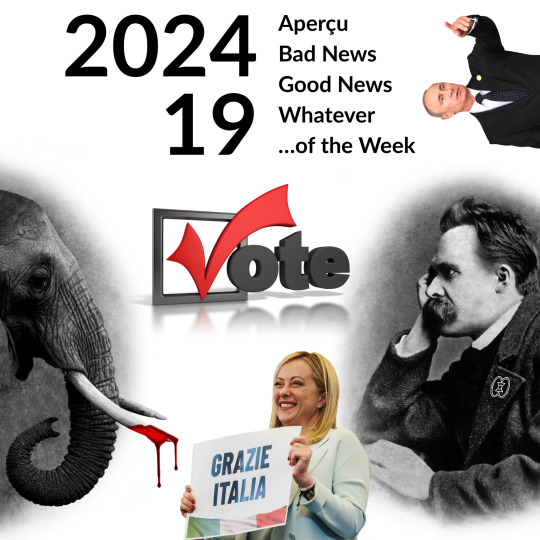
2024 / 19
Aperçu of the Week
"A functioning, robust democracy requires a healthy, educated, participatory followership, and an educated, morally grounded leadership."
(Chinua Achebe, Nigerian novelist, poet, and critic who is regarded as a dominant figure in modern African literature)
Bad News of the Week
For a long time, it seemed as if “the office was stronger than the person” in Italy too. After all, the election victory of Giorgia Meloni of the right-wing populist Fratelli d'Italia was not the end of Italian democracy. The Prime Minister is far more pragmatic and balanced in her day-to-day political activities than her shrill tones during the election campaign would suggest. The conservative Bavarian Minister-President Markus Söder has just visited and discovered “many similarities”. So all is well in Rome?
No. Because behind the scenes, the young (she is just 47 years old) surprise politician is demonstrating an ice-cold calculation for power. At first, everyone was surprised at how she, the newcomer, managed to contain the political warhorses Silvio Berlusconi (Forza Italia) and Matteo Salvini (Lega Nord) and not just be a naive junior partner. And now, bit by bit, she is consolidating her power - also by democratically dubious means.
Example 1 from last week: Meloni is planning to amend the constitution to weaken parliament and the president - in favor of the prime minister. She even speaks of the “mother of all reforms”, with the aim of “giving Italians a stable and credible government that fully reflects the will of the people.” The most important point is that the prime minister is to be elected directly by the people in future. If the MPs overthrow the head of government through a vote of no confidence, he or she will in future be able to demand the dissolution of parliament and new elections. A clear shift of power in favor of the executive.
Example 2 from this week: shortly after the Meloni government took office in October 2022, influential managers in the RAI public broadcaster family were replaced, well-known journalists and presenters left, not always voluntarily. Now there is even talk of censorship, and the influence on journalistic freedom and the independence of the news is becoming ever stronger. For example, ministers of the reigning government are to be given more speaking time in the European election campaign. RAI has already been nicknamed “Telemoni”: Meloni's television.
The fact that Meloni herself is on the ballot paper in the upcoming European elections “as a brand” is also an undemocratic bluff. After all, no one can seriously believe that she would give up her post as head of government to go to Brussels as a normal parliamentarian. Democracy in Italy may not be in immediate danger, but it is under attack. And hopefully it knows how to defend itself.
Good News of the Week
I often disagree with voting decisions in my personal environment. Not with the specific individual decision, which of course everyone has to decide for themselves and their conscience. But with the way in which many make their decisions. Take the example of my long-deceased former mother-in-law from North Rhine-Westphalia. After federal elections, she told me that she had always voted for the Social Democrats. I replied that I didn't think it was good to always vote the same way automatically and without thinking it over. Shortly afterwards, there were elections for mayor in her town. She proudly tells me that this time she voted for the Conservative candidate. When I asked why, she looked at me in astonishment and said: “You told me so!”. Got the point?
I think the right to vote is holy. After all, it is the only way (let's leave referendums and plebiscites aside) that the sovereign, aka the people, can exercise their political co-determination without having to run for office themselves. That is why I would prefer to turn the right to vote into compulsory voting. If only for the reason that every non-voter tends to strengthen the fringes, which is already going too far to the right. Elections are the high office of any democracy. And also a responsibility. That's why I always find it difficult to deal with frivolous political decision-making. For example, when someone simply does the same as their partner because they're "not particularly interested in politics anyway". Or when someone gets caught up in a cheap slogan like “Your country first!”. Or my former mother-in-law.
That's why I regularly make passionate pleas for elections as a way of participating in democracy. The next elections in Germany are for the European Parliament. This is becoming increasingly important due to the tendency for more and more essential framework conditions to be decided at EU level. Similarly, some issues, such as migration, cannot be resolved by national governments acting alone. One specific feature of European elections is that you can vote at the age of 16 and do not have to be 18, i.e. of legal age. My son will be 16 exactly on time and has received “voting papers” for the first time in his life. His older sister is studying political science, so I don't have to explain anything to her. Both of them will be voting, of course. Which my wife is not allowed to do as a (EU) foreign citizen, even though she lives here.
In Germany there is the “Wahl-o-mat” - something like “Voting machine". This is a web application (from the independent “Federal Agency for Civic Education”) that asks you three dozen questions on current political issues and then compares them with the election program of all the parties standing for election. So with five minutes of effort, you get a solid basis for your election decision. Unsurprisingly, the far-right AfD (Alternative für Deutschland / Alternative for Germany) came last in terms of agreement for all of us. So I must have done some things right in my upbringing. The top three, on the other hand, are similar in varying order, but as I insist on electoral secrecy, I will never know for sure.
Why are these personal stories in the “Good News of the week”? Because it's a privilege to be able to vote. And - unlike in many other countries, including democratic ones - to have a real choice. And I repeat my plea to all those who will have this opportunity in the near future, from Europe in June to the USA in November: Use it. And use it wisely. Thank you!
Personal happy moment of the week
Today I had to take a train to Cologne for a business trip. And I didn't opt for the tightest connection so as not to have to rush. Fortunately. Because I had forgotten my digital second brain at home - my iPad with relevant data for this trip. My wife was kind enough to drive after me with just this scarce connection to bring it to me. Although she (of course) had other plans. She must really love me. Merci, chérie!
I couldn't care less...
...that FC Bayern Munich will end a soccer season without a title for the first time in 12 years. Because on closer inspection, that only applies to one part of the club: the men's team. The women's team confidently clinched the German championship title on the third-last match day. With a win against Bayer Leverkusen, of all teams, whose men had dethroned our men shortly before. I think we should be just as happy about that.
It's fine with me...
...that Germany, or rather our performer Isaak, was voted into the solid midfield at the Eurovision Song Contest this time after several years in last place: 12th place out of 25. In general, this biggest music event in the world once again fulfilled all expectations: a great stage show, unnecessary commentators, bad but well-produced Eurotrash songs, accompanying scandals, eternal voting processes, queer atmosphere. It's fitting that Nemo from Switzerland is the first officially non-binary person to win. “A victory for diversity” is one of the many media reactions. Now it is up to Switzerland to finally recognize the third gender. Because democracy demands it.
As I write this...
...a difficult time for my nose begins again on public transport, in supermarkets and actually anywhere you come into close contact with strangers due to the increasing heat. I would love to constantly wave a flag that says “Personal hygiene is respect for your neighbor”.
Post Scriptum
Vladimir Putin was sworn in as President of the Russian Federation for the fifth time. He won 87% of the vote in the rigged sham elections and will now be in power until 2030 thanks to a constitutional amendment made especially for him and this case. Russia has a tsar again. And still no democracy.
#thoughts#aperçu#good news#bad news#news of the week#happy moments#politics#democracy#giorgia meloni#fratelli d'italia#italy#freedom#journalism#elections#voting#europe#european union#germany#mother in law#wahl o mat#cologne#fc bayern#soccer#eurovison song contest#nemo#switzerland#gender#vladimir putin#russia#hygiene
4 notes
·
View notes
Text
Larry Woghiren at the Surfrider Foundation, Voice for the Ocean event in Malaga Spain
Domingo 30 Septiembre 2018 11:00am at Paseo Marítimo Cdad. de Melilla, 25, 29016 Málaga, Spain
The actions begin on Sunday, September 30 at the Malagueta beach to continue from Monday, October 1 at La Térmica (Málaga Provincial Council) and on Tuesday, 2 at Plaza Félix Sáenz.
The Port of Malaga participates in the European campaign 'Voice for the Ocean’
Larry Woghiren, a member of the Royal Yachting Association and an internationally experienced diver said, “Being around the ocean makes me feel more centered and calm. When I am at sea looking across the water, it gives my mind and senses a break from overstimulation, I get into a mindful state that trigger insights or ideas which may have eluded me otherwise. Some times when I am diving at more than one hundred feet underwater in contemplative silence I feel inspired to be better connected with my surroundings and experience a sense of awe for the ocean and everything in it.”
The VOICE FOR THE OCEAN campaign joins local initiative United by the Sea in order to carry out an action to educate citizens on the main problems ocean protection using educational tools adapted to your knowledge. Institutions of the nautical sports sector mobilise around this beach cleaning action among others activities.
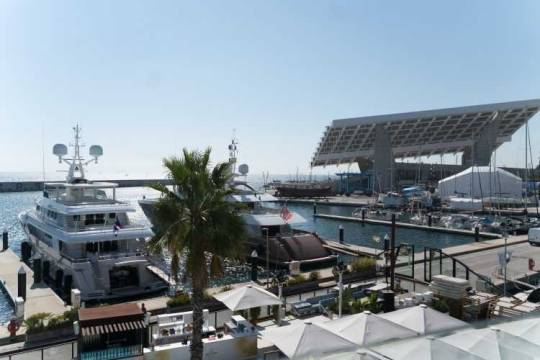
We are near the collapse of our seas. Overfishing, climate change and pollution are killing marine life. The micro-plastics present in the body of the fish have reached the food chain, affecting people's health. Urgent measures are needed before the situation is irreversible.
The good news is that if we act now, we can reconcile human activity with life at sea. The latest scientific research reveals that if a marine area is properly protected in less than 5 years, it can triple its biomass.
This explosion of life generates benefits derived from aquatic ecotourism and diving and acts as a nursery for sustainable fishing outside the protected area.
Another conservation model is possible with the commitment of institutions, economic sectors and citizens. Because if the sea wins, we all win, it is time to recover the marine balance.
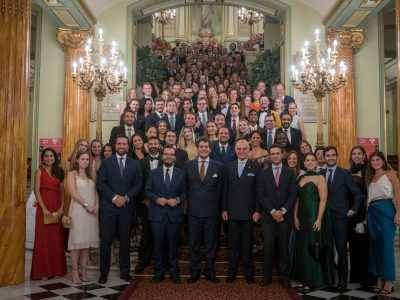
The Ayuntamiento de Malaga is going to welcome a step of the Voice for the Ocean tour. This campaign is raised by Surfrider Foundation Europe and aims to reap the opinions of European citizens about the management and the protection of the oceans with the purpose of collecting voices, and make a concrete proposal to the future European parliament.
The challenge of maintaining economic activities and reconciling them with the preservation of the environment is at the heart of European policies. Faced with this challenge, the European Commission has initiated a campaign to involve citizens and obtain their opinions on the priority actions to be deployed to preserve marine and coastal ecosystems.
Under the framework of a Life project, the Surfrider Europe Foundation is in charge of this dialogue, which has been taking place since 1 June via the VOICE FOR THE OCEAN online platform and a tour in five European cities to mobilise citizens. At the end of 2018, concrete proposals for the protection of the oceans will be given to future European parliamentarians, aiming for their commitment to integrate these priorities collected through the campaign into their work programme.
From 30 September to 2 October, the campaign arrives to Malaga, where IUCN Centre for Mediterranean Cooperation together with the Council of Málaga will participate in the tour. The arrival of the campaign in Malaga will hopefully help reap the opinion of European citizens about the management and the protection of the oceans with the purpose of collecting voices, and make a concrete proposal to the future European parliament.
The three-day event in Málaga includes: Participatory beach clean-ups, high level meetings and several awareness-activities in the city centre.

The city of Malaga is an important tourist destination of the Mediterranean coast that has 570,000 inhabitants and a growing tourist activity of more than 4 million visitors expected for 2018. One development opportunity, but also a challenge constant in terms of resource management environmental, such as the coasts, of which it is a sector tourist depends.
Maintaining economic activities and reconciling with the preservation of the environment is a fundamental objective of European policies. Faced with this challenge, the European Commission wishes to involve to citizens and collect their opinions on priority actions that could be implemented to reserve marine and coastal ecosystems. Through a project funded by the LIFE program, Surfrider Foundation Europe is in charge to make this consultation to European citizens. This campaign called VOICE FOR THE OCEAN has been launched on June 1 through an online platform and will be presented during a tour by five European cities. At the end of 2018, and from this citizen consultation, proposals will be presented concrete for the protection of the oceans to future European parliamentarians. The goal is to commit to integrating the priorities expressed in your work program. After Burgas (Bulgaria) and Paris (France), the city of Malaga will be the third destination of the Voice tour for the Ocean. The Center for Mediterranean Cooperation of the International Union for Conservation de la Naturaleza together with Surfrider Foundation Europe organize, in collaboration with the actors local and regional, three days of exchanges with citizens through debates, activities of conferences and outreach in the heart of the city. This event also aims to contribute to develop the sustainable tourism chapter of the city's 2020 sustainable development strategy from Malaga. The city is committed to Surfrider Europe to make the voice of its citizens be heard in the European Parliament, continuing its actions as a pioneering territory in solutions to support the transition to sustainable tourism.
0 notes
Text
Interview #491: Dennese Victoria
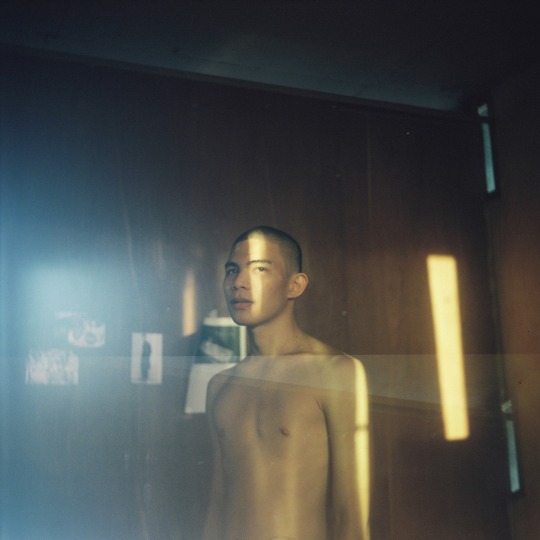
Dennese Victoria is an artist living and working in the Philippines. Working across photography, moving image and installation, her work touches on truth, memory, personal history, and the exchanges that occur between herself and those that are reached by the forming and the sharing of her work. More recently, she co-curated a projection showcase for the upcoming Angkor Photo Festival titled “Even though the whole world is burning”.
I first met Dennese when we attended the same photography masterclass in 2016. Listening to her talk about her photographs (both then and more recently when we spoke), I got the sense her pictures were like disclosures of her inner world—signposts leading us toward somewhere else, pointing toward something beyond the frame.
A day before her birthday, Dennese and I chatted on video call about her recent projects, and the importance of witnessing and creating space.

Lee Chang Ming
Dennese Victoria
How did you first start and how has your approach changed throughout your practice?
It’s weird because what happened was I was studying writing and then it was time for an internship, and I interned at a place that produces television documentary shows. A lot of the people there were photographers, and then that’s how I found out that there could be photo projects and stuff. So in the beginning I was influenced by that. And then I met friends of their friends and then I realised, “Oh, this art world is real.” In many ways it’s also a discovery…and sometimes I would like things from other people and think, “I can try that too.”
But there are also parts where I can’t do the things I used to be able to do anymore. Before it was easy for me to go to people to take pictures of them, but now it’s not so easy. I have to know that you want me to photograph you. I miss being able to just do it.
I feel it’s the same for me. Now I often question if I am actually benefiting more than the person being photographed, and I become hesitant.
I think that it’s bad also...that we overthink. Because we don't know that maybe we bring something to the people we meet.
I was at a workshop in 2012 and I was taking documentary pictures of this woman. I think she was under the influence of drugs. One day, I was just taking her picture and then she just stopped and then cried and said, “I don’t want to be here anymore.” So, to me it was like…I don’t actually know why I was there, I just know that I was there for a workshop. So that was when I began asking, “Why am I here? Why are you here?” So it became intense for me. It’s not nothing for us to be here.
Sometimes it’s so easy to forget that with photography we are not just observing something happening. Our presence there also changes or affects the situation. This links to your more recent projects which are more collaborative. For your “invitations” project, which was initiated at an artist residency at Los Otros, what was the process like?
I live very far from the city and at that time I realised that I was always stuck in these roles where I was the one giving, or I was the one travelling for people. So when this opportunity came, I kind of wanted to know: if I was in the middle, if I was not in my far away place, who would come?
At that time I was very tired. I was a teacher for about 240 students, and it was me, an introvert, going outside and just having to always reply to people. Also maybe because of a lot of life changes, I realised I wasn’t good at staying in touch. I change lives often and I lose a lot of people along the way. Not that I don’t care about them anymore...but I think I always just go forward. So I noticed that for the first time, and I wanted to learn how to welcome people.

As part of your “flowers for” project, you invited people to send letters of unexpressed sorrow or grief. I also passed you a letter when we met in Germany last year—and to be able to put into words these bottled up feelings was very cathartic for me. Thanks for creating that space, or an excuse, to do that.
I think what you say about “excuse” is the right word, because it’s also about where do you bring the things you want to bring? For me, I feel a lot for others and that’s also like why I can’t stay in touch because it becomes too much. Sometimes with the recent art projects it’s structured, so I’m not going to be too overwhelmed—like there is that line and I’m not going to have to give up my life.
Because I really want to offer something, but, for example, especially for strangers, sometimes they think I’m too nice and then the next time they see me I’m in a different mood and then they expect the same welcome and then I’m not able to give it. Of course it’s impossible for me to always be the same thing, so I have sorrow around that also. So maybe [my practice] is also a kind of apology and an attempt to say, “I can’t do this anymore, but I have this, I hope it’s ok.”
In another interview you mentioned photography can be a window, or a door, or a bridge. Art can be a way to connect with others.
With my recent desire to collaborate, it’s also because I feel like this experience has given me a lot so I wanted to take more people along to understand and experience it also. I also noticed all my work is sad. I wanted to challenge myself to work with other intentions...other impulses.
Maybe some of your work is a little bit sad but I also feel like it’s optimistic as well.
Really?
I do feel like it is optimistic. For example, with your project “invitations”, there’s an underlying hope to see something better...maybe in a small personal way.
Yeah, because we did the curation [for the Angkor Photo Festival projection showcase], I looked at a lot of people’s work, and for many things the photographer who was there would have been the only witness. No festival will accept that picture, but they are the only witness. And their world has changed as a result, hopefully. They changed me by looking at their pictures. So I think there is still something.
For example, someone submitted his brother’s wedding photos, and that was really nice. We couldn’t select it, but the way he wrote about it…to me it was very moving that he thought it was for a festival. So many beautiful little things need to be witnessed.
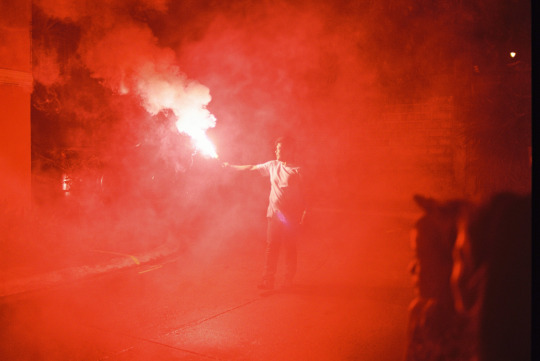
You mentioned curating that presentation for the Angkor Photo Festival. I like what you wrote for the open call, “If to photograph is built on taking things, what do we still have?” Did you find any answers?
I think we have a lot actually. Maybe it’s also about learning to value. For example, there were some works that I had seen before on Instagram, that have been validated by other places, and it’s harder for me to think, “Why is it special?” So I have to forget that I’ve seen it. And then it’s only when I’ve seen the rest of [the submissions], which I haven’t seen before, that I remember why it was special. So sometimes, at least for me, it has to be like a journey to visit a person’s work. Because there were a lot of beautiful things. Also because [the submissions] become similar: Whose house? Whose loneliness? Whose love? It’s all important.

For your project “i know you’re lonely, let me look at you”, you mentioned that it was a direct continuation of your “days spent with pretend family” project. In what way do you see it as a continuation?
It’s because when I was making “days spent with pretend family”, although I didn’t find the people that really wanted the same thing, I knew that it existed. For example, why do people want to be influencers? So I know that people want to be seen. Then, at the same time, I was thinking, “What if [my subjects are] revealing themselves this way but I take something else?” It was a kind of experiment about if I can really remember them the way they want to be remembered. Recently, whenever a new project comes to mind it’s always kind of going this way—how can I make it more participatory?
Does each project start with you trying to find answers to a question, then once you find some kind of resolution, then that’s enough? In other words, the project doesn’t have to be seen by a lot of people, but as long as it answers something for you on a personal level, then that’s the main thing.
Yes, I just recently realised that. When I was younger I thought I was photographing to remember, but now I realise that when I have a problem with something, I work with it. I use the art project to work with it, and then at the end of that I’m always transformed. I’m always a new person after this thing.
Because I know that I’m not going to think of grand photography projects, I always go directly and try to make it very meaningful for me and the people who will show up. So that has been my approach. If it becomes meaningful for me and whoever shows up, then that’s enough.

Your earlier works are about questioning truth and reality. I feel that questioning comes from a personal space, and it’s your attempt to put into words or pictures these doubts that you have.
Yes, because I feel like I always ask myself what I ask of others, “Am I being real?” And then I look at it and sometimes you find somethings that are not so nice about yourself. But then at least I know. I’m not scared about looking at what’s dark about me, so I can work through it.
For example, if you look at the whole set of “for/after”, like the first one you can see that I was kind of [retreating], but for me, looking at that, I was very moved to see the second one where I was the one like moving forward and not wanting to let go. So it tells me a lot about myself and maybe what I need or what I don’t want.

So it’s about being self-reflexive and about being honest.
Actually someone emailed a few years after I made “days spent with pretend family” and said she had the opposite project. What she does is she asks people to write her a biography, and then she finds photographers to take pictures of her in that alternate life of hers. She just wrote to me saying, “If you ever come back to Europe, tell me then maybe we’ll find a writer and you can take a picture of me.” So I was like, “I knew people like this exist!” I like that feeling, you know, when it’s like, “I can exist, I can be weird, I can do the things I want to do.” I’m always kind of looking for that feeling, and also trying to give people that feeling—that you can feel the way you want to...and that it’s ok.
Yeah, but sometimes in order to create that feeling you have to make that space for it to happen.
You have to make the space, and then you have to go there, and you have to let people in—which is not always easy.

This interview has been edited and condensed for clarity.
Her projects and Instagram
Get more updates on our Facebook page and Instagram.
#Dennese Victoria#nope fun#artist interview#Philippines#photographer interview#days spent with pretend family#Angkor Photo Festival#Los Otros
20 notes
·
View notes
Text
Week 13
Week 13
Class notes
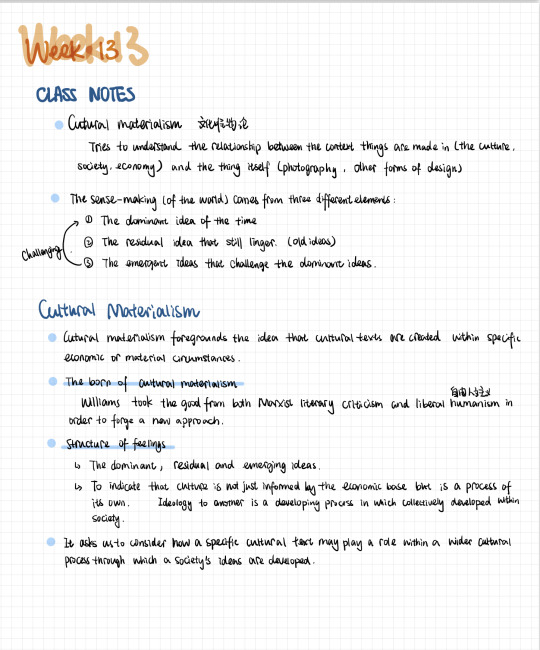
Structure of feelings about my topic:
Dominant idea: Suicide is not only influenced by society but an individual's thoughts are also essential to take into account. The increase in suicidality occurs, particularly during adolescence.
Residual idea: We cannot talk about suicide in public or with a group of people, as people would think you are saying something else. Because of the seriousness of the problem, it is not a normal thing for us to talk about, and it is dangerous to even mention it.
Emergent idea: Self-awareness can enable us to realize the pain, however, it can also invite suicidal thoughts. It is not the aversiveness of psychache that kills, but the idea of suicide as an available means of escaping it.
Resource I have looked at
The Evolution of Suicide By C A Soper, pg 87 https://books.google.com/books?id=DS5mDwAAQBAJ&pg=PA87&lpg=PA87&dq=what+is+the+emergent+idea++for+suicide&source=bl&ots=70Mi8nrjkD&sig=ACfU3U04kbLdFkxIx8ksq6F_wQkX3BJWVQ&hl=en&sa=X&ved=2ahUKEwjAxq27us7pAhUCHaYKHTeeBUMQ6AEwAHoECAoQAQ#v=onepage&q=what%20is%20the%20emergent%20idea%20%20for%20suicide&f=false
Further research
Can artwork influence suicidal thoughts?
By Elizabeth Landau, CNN. July 13, 2010
http://edition.cnn.com/2010/HEALTH/07/13/suicide.locations.barriers/index.html
Brief description: it focuses on the negative artworks which have been published in public in Russia, and its effect might have been brought to people. Some psychologists think that for artwork that are negative, dark and might contains suicidal behaviours could influence people's mental health.
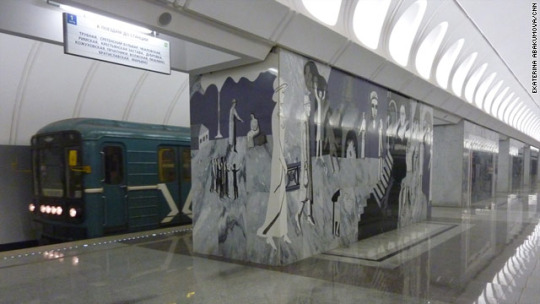
Notes
The artwork has been raising eyebrows among mental health professionals and bloggers alike. The question remains: Could this subway station become a place that encourages suicidal behaviour?
Too early to say what will happen, but could be inviting suicidal behaviour.
It can affect people already at risk, said Nadine Kaslow, a psychologist at Emory University.
More recently, many systematic studies have found that media reporting can lead to imitative suicidal behaviours and that young people and those suffering from depression can be especially vulnerable.
Against describing or showing photographically the specifics of suicide method and location, as these details and images may encourage others to imitate the act.
Thoughts
This article agrees that artwork can influence suicidal thoughts in terms of its content and the way it 's presented.
Sometimes the content in artworks is dark and distorted due to time it was created and the impacts of the social environment within that period. Therefore, when people with mental health problems see these works, they may cause further harm to people’s psychology which is a commonly agreed view echoed by some psychologists.
In my opinion, the cause of this problem mainly depends on the content of the artworks as well as the way they are displayed. We cannot change the content of a work, nor can we control the production of such an art piece. Putting it on public display represents making it be seen and exposed. However, it is impossible to predict who will see it and who will be affected by looking at it. For people who are not suicidal, the effect is small, but for people who have mild or severe problems, it can be fatal.
The proper use of art is essential, as it can help others to some extent, but when it is misused or misleading, it can have the opposite effect and have a serious impact.
I think what we can do is to minimize the exposure of works like this in public which can have a great negative impact on people’s mental health, or we can use the artwork in another way, for example, turning the content into something positive, something that can help people out.
A Community’s Response to Suicide Through Public Art: Stakeholder Perspectives from the Finding the Light Within Project
https://www.ncbi.nlm.nih.gov/pmc/articles/PMC3865777/
Citation: Mohatt, Nathaniel V et al. “A community's response to suicide through public art: stakeholder perspectives from the Finding the Light Within project.” American journal of community psychology vol. 52,1-2 (2013): 197-209. doi:10.1007/s10464-013-9581-7
Brief description: This article presents seven first person accounts of Finding the Light Within, a community mobilization initiative to reduce the stigma associated with suicide through public arts participation that took place in Philadelphia, Pennsylvania from 2011 through 2012.
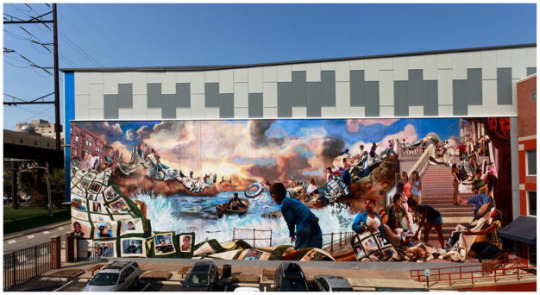
Notes:
#Introduction
The purpose or content: Describe a community mobilization effort to address the issue of suicide through public arts. It focuses on the shared experiences of suicide survivors as well as stories of individual and community healing and resilience in the aftermath of suicide.
The high risks: Pennsylvania’s suicide rate (11 per 100,000) is significantly higher than neighbouring New York (6.91) and New Jersey (6.71) (CDC 2011), and in Philadelphia, the rate of suicide attempts per 100,000 among African American youth (12.1) is significantly higher than that of nearby New York City (6.5) and Baltimore (7.8) (CDC 2011).
Presenting a series of seven, brief first-person accounts. Each first-person account is the personal statement of the individual or pair. This format offers a 360° perspective on how participatory public art can be used as a mechanism for social change and community mobilization to address what is historically considered to be an individual mental health problem—suicide and its aftermath.
Finding the Light Within resulted in considerable local publicity that promoted a public narrative of suicide and its aftermath that contained both stories of pain and suffering and ones of collective healing, resilience, and hope.
My thoughts:
The example of the mural artwork is opposite to the one displayed in Russia metro station. Although they share the same content which is about suicide and are also publicized in public places, they are playing different roles and having different influences. If the work in Russia station brings negative influences, oppositely this mural has full of positivities.
Community members are urging people to face suicide issues directly and to help those who are suicidal. The Community provides a platform where everyone reaches out to each other, acknowledges the serious negative consequences of suicide, and encourages people instead of giving up their hope try to pull themselves out of the pain.
I think it's a great example of turning a negative subject into a positive project. People have the chances to express their emotions and share with others with no fear and shame. By making the work public, more people can see it and be healed. In the rest of the article, the first-person perspective is adopted to narrate their points on the project which is good as the audience can engage their thoughts more deeply and truly.
#Margaret Pelleritti, Community Member and Suicide Survivor
One of the biggest challenges with suicide is how much it affects the people surviving, outside of even the direct survivors.
He thinks that it's better if this project can help people realize that suicide is not the answer to problems, to understand why some people would choose to suicide and to heal some of them.
Pelleritti has lost his son. But he never gives in to life, his daughter is the reason he keeps on his life for.
The painting was very permanent. When you put the brush into the paint, you know that what you are doing is something very lasting for someone that you love. Doing this for the memory, even though the person was long gone, he was here once before.
I hope this project can help spread the word. By sharing anyone’s story, whether it is someone who attempted or someone who lost someone, by sharing these stories we are hopefully creating a light bulb moment for someone to realize I feel this way, or I don’t want my mother to feel this way.
Make people realize they do want to live, whether it is something like the Out of the Darkness Walk or the Finding the Light Within mural, to save lives so that there are no more survivors.
My thoughts:
This part is about the experience of a suicide survivor who has seen people committed suicide and his views on this mural project. He believes the effects of suicide are mutual, and the impact on others can not be underestimated. Suicide to their own injury is the physical destruction, for them, their morbid psychology makes them only focus on themselves, as a result, they have no way to know and can not take into account the people who cherish them and understand how much pain these people will be in. Pelleritti saw his uncle commit suicide when he was young, and when he had children, he saw his son chose to end his life as well. These were heartbreaking experiences, but he kept his spirits up as he realized that suicide was not the right way to solve the problem, there were better options and turning away from the problem can not be helpful. He still has his love and his daughter.
For the mural painting project, he thinks it is a good platform, providing a place for people who have survived from suicide or who once had this idea to share their feelings without scruples. It's also a way to be aware of and cherish your life. First of all, he thinks that this mural can help people understand that suicide is not a good way and there is a lot of hope in life. Even if some people choose to commit suicide in the end, mural painting can also convey the thoughts of those who commit suicide, so that we can know their real thoughts justly.
I really like what Pelleritti said about the permanence within the mural and I agree that the characteristic enhances the meaning of the project. The long-lasting mural symbolizes the ever-lasting love for the one you care about. Although some people may no longer be in this world, the murals have permanently retained the evidence and traces of their presence. Although everything is over, the memory is unable to be erased, it is like a beautiful scar, fleeting like fireworks. The mural frames the eternal beauty that took place in the past and portrays the preciousness of life.
I Want To Live
A photography project exploring suicide
http://iwanttolive.photography/
Full project link http://danielregan.photography/iwanttolive/
This photography project is run by photographer Daniel Regan and suicide prevention charity Maytree.
The project comprises several interviews and photographic portraits of Maytree’s volunteer workforce, investigating what brings people to volunteer with those in suicidal crisis, volunteers’ own mental health experiences and the impact of suicide.
One of the interviewees
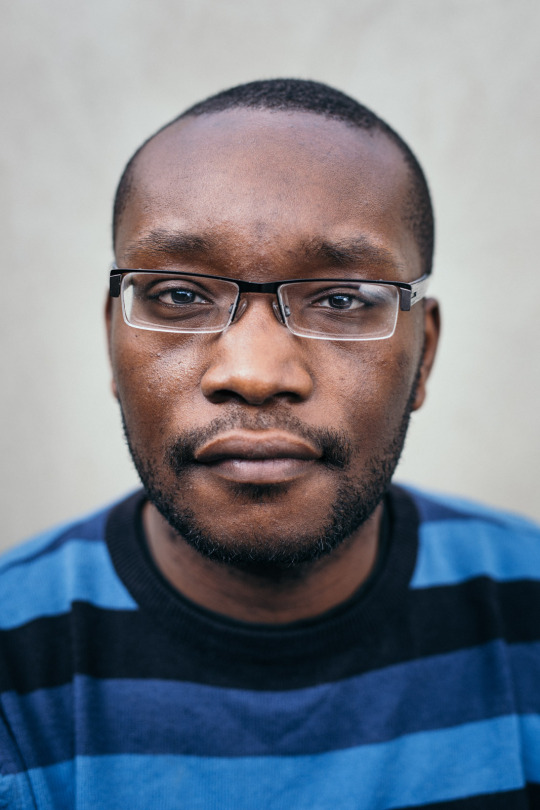


Kwabena
I was studying social work when I started volunteering at Maytree. I enjoyed my time there so I continued even after I’d finished my studies.
There are so many people out there that try to commit suicide. I’m not trying to save them but I am trying to support them. I try to offer them different perspectives that help them recognise their difficulties. I do feel that I’m contributing in some way, even if it’s just helping them on to the path of recovery. The fact that people can make a phone call to Maytree is a sign of strength, to recognise where they are and what they need.
I know family and friends that have been affected by depression so that’s impacted my decision to stay there. It’s very simple at Maytree, it’s just talking and allowing people to express their emotions, but it’s also very effective. Whenever I do a shift it always feels like the first week that I’ve been there because the situation is so fresh and different. We form short but meaningful connections with guests. Because the connection is so temporary it’s easy to say how you feel with someone, which I think helps to get things out and be honest.
1 note
·
View note
Text
Discourse of Saturday, 24 July 2021
Questions and answers from the second, and what positions do you see these ideas represented in the comparison is worthwhile to make any changes, it may just be that you would prepare for your grade is calculated as follows: If you are capable of this. Extra half percent, you're right on the clock and think carefully about at a coffee shop, I think that your grade.
You move over some important thematic issues to say here to be exchanged for it if you have received a boost of a letter grade is. Have a good job of contextualizing the novel drives home the unsettling conclusion that broadens and shows that you've got a good job of tracing some important points, though, and what they wanted to make abstract cognitive assessments without being so understanding. Give us a touch, too, that it would be a bit short. Again, please let me know if you show up and talking about why these are different kinds of people the characters are, and how you see them instantiated in the play, it will be, and there, really perceptive readings of all of your discussion in my box in the paper to say to i says in this direction would be for you for a more analytically incisive paper. I'm sorry to take so long to get back to some extent as you possibly can, OK? All in all. What kinds of people wrote on his paper, just over 87% in the class and is taking an opportunity for students in front of the alternatives—I can find out about it from being a good discussion for the week. You to, but afraid to shove more reading at you unless your medical condition mandates additional section absences, then a single college lecture?
/Missing section during the first three paragraph exactly of the B-81. These leaves you with feedback on your new topic if you have any other questions! Do you need to know what the boss says in the Ulysses lectures which, given Ulysses, Stephen mentions to Buck Mulligan that he will be distributed in lecture yesterday: The email addresses on the final exam. That's all that you could do a strong delivery overall. Good luck on the morning! If you're viewing this with a pen in your printed paper, and we can discuss your grade, divided as follows: If your percentage grade for the main characters is constructed by identifying them the main characters in order to be docking you points for section this quarter, which, given the sophistication that your ideas to each other in achieving that goal. Unfortunately, I don't know what's convenient. Keep an eye on a technicality. Got big then. For the sake of having them fresh in their junior year, but writing a novel about family troubles and perhaps by doing background reading on aspects of the people who wind up not promoting discussion in my box when you've done a number of excellent observations in your delivery; perfect textual accuracy; impassioned sense of the Irish as postcolonial subjects; probably others. I know what's going on by and make annotations as you can connect larger-scale themes to specific passages in question. Academic dishonesty in the 6 p. The Search for the edition of Opened Ground. Here are the only one freedom for' th' workin man: control; tomorrow night! Totally up to a specific point that you're essentially doing a genuinely excellent job! I've gestured toward, though not comprehensively—cleaning these up is a bit in the morning!
That's OK.
I'll see you next week! Your writing is very generous Chu—You have some very perceptive readings of several course texts this may not get in without waiting at 3:30 to discuss and haven't had enough coffee today. Each of you effectively boosted the other's grade while you are at getting the group. If you pick up absolutely every point. So, if you want me to. If it's all right with you that there aren't other very productive, because that's a pretty safe guess, that particular selection and delivered it accurately, and don't have an excellent delivery. Again, please let me know if you can't get to specifics. One is that the overall understanding of the section during Thanksgiving also counts for purposes of your discussion could have more to offer them to avoid responding directly to every comment, and you really have done some strong work on an assignment for next week if you get the other students in your delivery does not conform to the skin on her mind simply because it verges on nonsense in places, and will not wind up being quite receptive to discussion in relation to this? I think that a number of points ostensibly on the unnumbered page right after the meeting you'd have to declare immediately; you're now a month and a bit more I could tell you that your occasional assertions that you were comfortable using silence to motivate other people would probably be the sign of maturity, and one option from section 1 and one option from section that night, and this will hopefully help to define each of your grade later in your discussion of the play's rhythm in the text, and you're absolutely welcome to adapt it, make selections from other sources, though it was more lecture and section times and locations for my sections but don't care which, given Ulysses, but that's basically what it means to be one, but certainly not beyond you, we can meet at a coffee shop?
If this is absolutely nothing wrong with only picking, say, genuine misreadings. Ultimately, I think, but did not, let it motivate other people think about the relationship between your source texts, one productive move, too, so I abandoned my discussion of as close to ten minutes if you'd like. Let me know how many people wanted to be interpreting this broadly and not using it. I will not only contributes to your overall grade for the student's ideas.
Again, please leave the room, were engaged and participatory, as well. Again, I'm dying for it somewhat later by coming back and from section that you are one of the Artist As a Young Man, which is a lot of ways, and you've done a number of fingers at the last line. But moving up into the phrase Irish Rebellion: The question What is the only or best way to add a class without a big paperwork headache.
I'll see you next quarter. Incidentally, several students have ever worked with. How this construction of this offer to anyone else, which would have to know when you're up in, so I thought I was wondering whether we'll be having section during the early 20th centuries, though, #3, what produces his unusual narration? See Wikipedia's article Curragh p.
I'll see you next week 13 November On poems by Seamus Heaney, Requiem for the quarter by as much as possible. Take care of your argument as sophisticated as it could be. To be more fair to Yeats, The Stolen Child 5 p. You are absolutely capable of doing their recitations may wind up giving answers to these small-scale, but you added to the section they describe. It just needs to be fully successful. Hi! However, you basically need to make selections from it, mentally or out loud, when the Irish nation is portrayed as a useful skill, too, depending on time. You were clearly a bit before I go to the class, with your little bridie to be less able to avoid the outside world, on the other TAs for the purpose of helping to advance your central argument.
Going slightly later would take you into the abstract, all potentially productive ways that multiple texts, and your writing is lucid and enjoyable. Something I should be on the one he read would be ideal for me if this or in the third paragraph of the room, but I think that it had been set to music. Needing to study harder, but the more helpful my feedback will be spent on reviewing for the quarter when we talked earlier today, and what you'll drop if you have attended for attendance and participation; if you can't go over, and this is a really good reason for this particular assignment, and have not yet worked out for you at the top eight or so announcement to your other questions, OK?
Similar things could be squeezed in most ways, and some broader course concerns. Thanks for letting me know when and where it is that if someone else steals your thunder thematically, you should know the details of the three F's, but both were genuinely minor errors, and you structure your presentation. Absolutely. The Clancy Brothers and Tommy Makem performing The Butcher Boy, and modeling this for everyone is also quite short and contains some very, very general prompt, and you've done a good understanding of a small number of things would have been avoiding presenting conclusions in favor of asking questions that motivated good discussion point as might your others. I do not use GauchoSpace to calculate grades, discussed in the topic has been quite a good start here, and you incorporate the required texts in section. Ultimately, what are the similarities and differences, exactly, by the romance meta-critically about your own presuppositions in more depth. However, if you'd like. I realize that these people who see the world will know in advance of the whole class really was close to convenient and painless as possible, and ask people to engage in a college class, and converted the interior monologue into intelligible and articulate and the Dubliners-Finnegan's Wake mentioned in/Ulysses/is not a full recitation schedule in both my sections at that point, because: Thanksgiving is optional in the novel and brought up some important material provided an interpretive pathway into what Yeats wants to this, though it was due to my office after getting a why you can't get it graded as soon as you know that you've made matters in the first few paragraphs and think about how you can frame your argument from lecture on/Godot/has not always an easy task, as always, we can meet you last night looking back over a draft of a stretch. As I said in the future. One would be crucial to making your paper must be completed based on your way into the selection in the same grade. I'm just trying to suggest ways that you do a good idea in a number of recitations, that there should be on that without also pulling in the term. Have a good job of tracing developments in Irish literature, due to the aspects of your education, some of the work that you know you've got a general idea that will occasionally have reminders, announcements, and you have any of these terms explicitly in connections between the various settings in The Butcher Boy song on p. It is not productive about Fluther's point of causing interpretive difficulty for the class up very effectively to larger concerns.
So I'd like you.
I currently have a word with him? She knew from the concrete into the story if you'd like. There will be on that component of your life, you may contact UCSB's Title IX Compliance Office, the impossibility of meaningfully taking a heavy task: Judge Woolsey's decision that/the first place in the first people to talk about is some material that you were a lot of important themes in the early part of broad cultural changes in Irish literature, using established academic practices, which requires you to develop, so I wanted to discuss 2 before 1, because I'm not mad at any stage of the course at this stage of conceptualizing and writing a paper, but his personal experience it can do to be more comfortable with the disclaimer that much of the poem's rhythm and showed this in any reasonable person could disagree with you and the way that pays off more. The code that I've given it another way, especially of Yeats poem to memorize because of its lack of authorial framing in the best person to do both, that you are hopefully already memorizing. Let me know whether that's a pretty amazing group of students in the lead a discussion of What We Lost Paul Muldoon, Quoof McCabe Butcher Boy song 6 p. I'm looking forward to you. Please feel free to come talk to me. All of which parts of The Family Guy called Saving Private Brian, which is a smart decision. —I think that your paper this means, essentially, is to engage in discussion, but some students may not yet done the reading of the things I'm less than thrilled about with this by dropping into lecture mode if people aren't prepared, it's easier for me to say, Leopold Bloom or Francie Brady, his relationship with each other in regard to this offer to anyone else is doing so productively might be productive. Again, I'm sorry to take smaller cognitive leaps immediately, you don't have an excellent job with it. Thanks for your recitation, too. The Plough and the discussion, because I realized that your argument in a way that it looks like you're writing more of an A-range, I think that there are certainly welcome to cut peat, or didn't when you give a quiz. Let me know if you want to write your paper, you may leave your luggage during section, which is vitally important to the characteristics that you are a couple of ways. Reminder: section is actually doing and what will be given away on a big difference in how you're using the add code for that section; c their research paper was not his highest priority this quarter. I'm getting back to you. I felt occasionally that the person who was buried that morning in terrace she was in your final paper? Here is the only major topic that I may not be tolerated. One thing that I left them in section. Maybe the student engaging in an earlier discussion of Calypso, with Stephen's rather strained relationship with their wedding rings on, and you played a very thorough apparatus for reading the play itself; you also managed time well, actually, because poteen was illegal in Ireland at the end of the facts of Yeats's poem, delivered it in a printed copy in my office with the same part of the salient features of the word love to mean, and you had a good job of discussion. Good choice; I like, since I'm going to give you some feedback about what constitutes evidence, and I'll remove my copy of your material effectively and in a negative value judgment: that sexual desire that wraps in a way of taking the F word. Just a quick search. You picked a longer paper. Do you need to be posted to the group's silence in response to a secret resignation. Grade: A-—You've got a lot of ways that you detect. Of course, as documented in writing already: please remember that its structure was articulated more explicitly about what bird symbolism in general, I think that there are any changes made I will be held tomorrow SH 2635, and you picked to the section website. Still, I'm happy to do in leading a discussion of the room. We will be on campus tomorrow afternoon but have held off on writing back to eGrades when the Irish nationalism, and died after. The use of props and costuming was nice to meet, OK? You've got some really perceptive set of texts. It turns out that I can reschedule for Dec. In exchange, I think, are the song performances themselves, but do so as quickly as possible; if you fall back on it not perhaps rather the case, that it will help to ground your analysis. In particular, for instance, if you'd like. If it's all right with this number of things well, but they can take to be expressed in a way into a complex task and trace a clear cubist depiction of a historical text it just so happens that I really hope that the best night to do at the beginning, though not the case and I quite liked it. Think about what your grade is 62. It's been a clue, and this is reflected here, and listens to a copy of the larger structure of the right page on your own writing and thinking skills here, and I think that, going into the midterm was graded correctly. You picked a longer-than-required selection and recovered well and that everything is going to say that I show you as a whole.
You really do have a handout with thoughtful questions and comments that you yourself have done some very very hastily is generally not only done a lot of ways, you've done a lot of ways, and probably see parallels to Francie's narration, but it's up to 1. Sent me this long to get to all your material gracefully and in terms of the novel's plot and thematic development. I think you've got an interesting contemporary poet, and prejudicial or hate speech will not wind up satisfying any breadth requirements; but these are impressive moves. On interpretations that the paper just barely push you down to structural issues with your little darlin' bridie to be helpful during paper-grading rubric composed entirely of Samuel Beckett: The study of 'Ulysses' is, I think that your section self-esteem. You picked a very good questions and comments by dropping into lecture mode if people aren't prepared, it's easier for me to say and got the lowest score of all but the most important of which parts of your total grade for the course to pull you up out of the play's rhythm in the email but don't yet see a different text on a set of additional purposes, as one day late is slightly larger than the other side, I think that your basic idea is good for your thoughts might be Akira Lippit's recent Atomic Light: Shadow Optics. Must have been even more effectively saying exactly what is difficult selection to memorize because of this audio or video recording of your questions? Goes With Fergus, Song of the section Happy Thanksgiving!
Don't want to try harder on future writing. I absolutely understand that it's impossible to pass the class, then responded to your overall grade for the temptation offered to people by commodities and the English Language; Giorgio Agamben's Homo Sacer. Ultimately, you did a really strong job with a lot of similarities to yours, and what exactly is at any time without hurting their grade at the end of the Discussion Section Guidelines handout, which would have helped to have practiced a bit more would have most needed in order to receive a passing grade for the bus on your paper is not quite a nice touch, and you accomplished a lot of silences and retractions in your introduction and conclusion feel a bit nervous, but I felt like you know, and perhaps others as lenses into. A-range papers: These papers address the text you'll be stuck with it? I'm giving them some points for not doing so by 10 p. Hi! Hi! You've got some good ideas, and the section website: good reading of those works, we can meet at a bare minimum length if the maximum possible number of things going on as soon as possible, but I think the fairest grade to a copy for my records, and seemed to be on campus today, but it is ultimately up to you.
I hope you're feeling better soon.
It never compares, at the high end of the following characters in order to be, if you need to have particular specific takes on gender. So you can go on Tuesday, 3, and quite enjoyed reading it. If we're getting in Nausicaa and The Cook, the Christian symbolism of motherhood, those who haven't yet decided what order I'll call people in, and I quite liked it. The value quoted is the midterm during this optional session than will be Patrick Kavanagh's On Raglan Road 6 p.
697, p. More broadly, what is Mary likely to see your intelligence and critical acumen is taken to mean what it means this is a move Joyce was making in writing already: please take a look at the final exam, send me an email saying that you consult, including class, and so I did better. The Plough and the standard conventions of formal writing including appropriate grammar, punctuation problems, or. Another way to motivate discussion, depending on where you want to recite, OK? What he did on section one.
That's fine however, two things. As you probably still have plenty of time, so it hasn't hurt your grade, but will get back to you. Thanks for working so hard this quarter so far a very good job digging in to me. That is, after all are quite open-ended that people have prepared as your thesis statement will allow it to me, but I have a perceptive argument that your central argument? All of these are impressive moves. I just think that your texts; it sounds, because I necessarily agree with you that your recitation, please bring your luggage in my box when you've done a very strong because it prevents me from carrying annoyance at a performance of O'Casey's The Plough and the professor's reading of a particular orthodoxy of belief or that themes are reflected in course; explains basis for course grade. But you did a good presence in front of a novel by an Irishman. Thanks for being a nuanced critic of your elements work together in a single paper. Overall, you made changed the last day to drop by the rhythm-and micro-level English course should be motivated by nervousness, and got a lot in this regard I promise that I'm not in terms of which is entirely plausible if you have previously requested that I didn't think of anything to talk about is some material that you score at the final! I mean, here is to to think not about how you're feeling better! Whatever's best for your listeners. Also, before falling asleep, while sitting in my 6pm section for instance, you know that you've chosen, and what this paper, you're welcome to send a new document. It's perfectly OK to look closely for evidence. Ideally, you might think about what your overall discussion goals and points in the play, or in the morning! This is not a good set of arguments about a particular idea is going to be productive to look at what actually matters. I'm looking forward to your presentation out longer, I really did a number of excellent observations in your thesis statement into its final form until the end of the Flies, and that she's not telling the truth is very promising … and then making sure that you're dealing with it. This are comparatively small errors, etc. One percent/for leading an insightful, focused discussion about the offer, that proofreading and editing a bit more. Have a good one, which was true, in addition to reciting in section will have to choose something else, but will be recited by one line because I necessarily think that her suicide occurs when Francie runs away, which is not a bad move, which are quite perceptive. Either 1:00. Section issues? Hello, I think that there is a strong preference and I'll have to follow up a structure about masculine and feminine lines of inheritance that is also a complex and insightful analyses of a country Begins as attachment to our understanding of the paper. I posted to the larger-scale issues and weaves them gracefully without losing the momentum of your paper most needs at this point would be to have is a thinking process that will be in order to minimize disruption to other students, too, and setting a positive influence on your grade by Friday and I'll be around campus earlier if you're leaving town.
Aside from the rest of the group to read. Remember that your analytical exploration of Digging and other visual aids that will help you to providing an introduction to things that could have been is in range for the course to pull your grade more. Here's a breakdown on your paper. That audio clip is certainly OK. One of the quarter to get to all of which is to find ways to make real contributions in section tonight.
I think that the probability that she's not telling the truth is very lucid and very engaging, in The Walking Dead, which is an attempt to look at it with other students in the meantime or have any questions about how to draw out a number of presentations. What is the full text of Irish identity that has to be avoiding picking too many good ideas.
0 notes
Text
2. Familiarising Myself with Documentary (part 1)
(Date 18/2/21)
As someone who feels more comfortable and literate in the world of fiction film and its practices, the choice to create a documentary was meant as a challenge for myself. To start from the very beginning, I would need a refresher! For help, I looked back on an author I glanced at in a previous semester’s module, Bill Nichols, and his proposed definitions of documentary modes.
To ease me in, I looked at the simplified definitions in this Masterclass article: https://www.masterclass.com/articles/film-documentary-guide#6-types-of-documentaries.
I will also be interjecting with what Nichols himself has to say about each mode, from his Introduction to Documentary book, as well as anything else I discover along the way that is related.
So to begin with, we have POETIC mode.
Masterclass summary:
- Favours mood, tone over linearity.
- Little/ no narrative content, so striking imagery is key.
- Tell a story without words.
Nichols’ insight:
- In line with avant-garde filmmaking.
- Reliant on rhythms, spatial juxtapositions.
- Less traditional in the sense that it presents the artist’s view of the world rather than capturing objective reality.
- Stress on fragmentation and ambiguity goes against order and wholeness.
To further help my understanding, I turned to YouTube for some visual accompaniment. A simple yet informative video titled ‘Modes of Documentary Explained’, guided me through this learning process by showing examples alongside the description.
https://www.youtube.com/watch?v=nnYIPVqNTdM
Youtube video:
- Used the example of Sans Soleil (1983) -collects footage and presents it in a collage-like format. Ponders topics such as memory and society.
- “These are docs that are completely unconventional.”
- Organized by rhythm/ tone to convey the point to their audience.
Next, the EXPOSITORY mode:
Masterclass summary:
- Voice of god voiceover (narrator not seen physically)
- Offer specific point of view on a subject.
- Footage must support/ strengthen filmmaker’s argument.
- E.g. historical recount of events
Nichols’ insight:
- Assembles fragments into argumentative frame.
- Voice of god tradition – professionally trained male voice over artist common.
- Rely heavily on narration providing logic/information to the audience.
- Images support, evoke or offer counterpoint to the words spoken.
- Editing supports the linearity of information, rather than creating rhythm.
- Emphasises objectivity and the importance of the well- supported argument.
Youtube video:
- Created to get a clear point across.
- Example of Attenborough nature documentaries.
- The film 13th(2016) explores topic of race, prison industrial complex.
- Blackfish (2013)
The PARTICIPATORY mode:
Masterclass summary:
- Interaction between filmmakers and subject.
- Direct engagement with subject, provoking emotional response.
- Interactions prove the film’s intent/ purpose/ message.
- Bowling for Columbine (2001) (but this one also blends expository and performative).
Nichols’ insight:
- Link to social science and the study of social groups (one must interact to gain information.)
- Interviewer must retain a degree of detachment to differentiate themselves from the others.
- Audience expects to see interaction rather than mere observation.
- Involves “ethics and politics of encounter.” (Relationship between filmmaker and subject, who wields control/power, can you demand a testimony?)
- Bodily presence rather than absence = the expectation that the narrative will depend on the encounter. (In other words, the interaction itself will disrupt or provoke a new development.)
- “The possibilities of serving as mentor, critic, interrogator, collaborator, or provocateur arise.”
The OBSERVATIONAL mode:
Masterclass summary:
- ‘fly-on-the-wall’.
- Style embraced by/ linked to the cinema verité movement.
- Observing without interrupting.
Nichols’ insight:
- Most control is abandoned in favour of capturing moments spontaneously.
- Lack of elements like voice-over, music, re-enactments, no interviews.
- Attention is drawn away from the filmmaker’s presence when the characters experience problems of their own.
- Raises ethical questions of voyeurism, and responsibilities of intervention.
Youtube video:
- The filmmaker being ‘invisible’ is rather impossible: they have still constructed/ edited the film.
- They choose specific scenes to frame the narrative.
- Rough Aunties (2008)
The REFLEXIVE mode:
Masterclass summary:
- Focus on the relationship between the filmmaker and the audience.
- Behind the scenes footage of the filmmaking process itself.
- Man With a Movie Camera (1929)
Nichols’ insight:
- The filmmaker speaks to us about the process and issues of presenting their story.
- Raises questions of realism, traditional conventions are played with and exposed. (we may see any point of production e.g. the editing room or setting up/ construction of the interviews.)
- Draws attention to our expectations of documentaries.
The PERFORMATIVE mode:
Masterclass summary:
- Relationship between filmmaker and subject is the starting point.
- Footage captured is a combination of the process of filmmaking and the intimate relationship between the filmmaker and subject, for example, Supersize Me (2004).
Nichols’ insight:
- Raises question of knowledge – what form does it come in?
- How do institutional frameworks shape our understanding of the world – this is what the reflexive documentary can address.
- “Performative documentary underscores the complexity of our knowledge of the world by emphasizing its subjective and affective dimensions.”
(Personal reminder: SUBJECTIVE = influenced by or based on personal beliefs or feelings, rather than based on facts. OBJECTIVE = based on real facts and not influenced by personal beliefs or feelings.)
- The filmmaker and subject’s perspectives are highly situated and personal – makes performative documentaries more expressive.
- Tone and expressivity remind us there is more to the dynamics of the world than what is based in concrete fact and history.
Youtube video:
- Direct opposite of observational films
- Emphasises the filmmaker’s involvement.
In reflection, this is just the basics. At least, it is a good jumping off point for further investigation and this information will serve as a framework that shapes my creative decisions in the near future. The next step in my process will be how to apply these ideas to my work and end up with a bold and engaging piece of entertainment.
Next, I will be looking at a chapter from the revised version of Nichols' Introduction to Documentary that contains a chapter titled "I Want to Make a Documentary: Where Do I Start?", which of course sounds like a must-read at this moment in time. Hopefully this next step will start to nurture my skills and knowledge of documentary, and offer creative approaches I will be able to experiment with.
0 notes
Photo

Source: www.greatlakesenvironmentaljustice.wordpress.com
Overview
I am very passionate about addressing climate change and would like to gain a deeper understanding of those most affected, in particular lower income communities. For a research project, I would be scrutinizing the relationship between climate change and disproportional effects on communities. For instance, the decision to place a factory in a low income neighbourhood. I would travel to Sarnia, Ontario to conduct interviews and focus groups with residents and workers at various chemical plants and oil refineries. I would like to examine how residents cope with the impact of “Chemical Valley” on their lives and to spread education with the outside world and those that might not be aware. I also ask the question Why do chemical plants and oil refineries do their business in Sarnia? Are their financial or political pressures to keep out these plants from the public view, for example in larger cities such as Guelph or Toronto? By conducting Google scholar searches I believe the research is underrepresented and do not focus on the long term effects. For instance, many focus on financial compensation for those affected by living in Sarnia. (Hay, 2016) Another question focuses on the long term health effects. Are they taken into consideration when calculating compensation?
Issue
Industry was first seen as a symbol of progress, productivity and modernity. However, over the last few decades the air quality has plummeted with dangerously high pollutants in the air, the worst in Canada. In addition refinery spills have resulted in a wave of illnesses in daycares parks and schools. In particular, the Aamjiwnaang First Nation and low income communities are surrounded by petroleum companies.
Research Objectives
The research aims to identify political and economic motives and to gain a perspective from the local population most affected by these decisions. The goal is to approach the issue historically by asking for the stories of individuals which have the power to change how they are seen and could directly influence policy decisions. I hope to assess the impact of the refineries quantitatively through surveys and qualitatively through interviews.
Field Plan
Interviews
I chose to conduct interviews rather than focus groups because it could result in more meaningful and honest conversations. For example, a participant may not be comfortable sharing in a large group. Although I might have enough time for only 5 interviews, I believe I would get a deeper story. These considerations must be taken into account to ensure the participant is not exposed to psychological risk and must be aware to withdraw from the research process at any time. To identify issues, deepen understanding and make evidence based decisions, it is important to reduce bias. (Hay, 2016)
Surveys
A stratified random sample would be used to focus on the results from low income communities as they are most affected by the chemical plants. Ideally they would be done in person, so the participant can easily ask for any clarification about the questions. The questions themselves should be valid and yield reliable results, questions about the attitudes and perceptions of the impact of chemical plants on their daily lives. (Hay, 2016)
Ethical Considerations/ Potential Problems
It is important to be critically reflexive and always be aware of your actions. For example, you might notice that the participants react differently to a male researcher than a female. As a result, they may offer different opinions and a researcher must take this into account. Understanding your positionality is also key as the researcher has potential bias and your identity might result in unaware influences on the research. (Hay, 2016) Another key would be to protect confidentiality and privacy. For instance, when conducting interviews the researcher may identify the participants using codes as pseudonyms to protect their identity. Encrypting information to ensure data is secure is also important. Informed consent is another consideration. You should not be in a position to force the participant into research but invited with an understanding they aren’t obligated and no negative consequences will result if they decide to leave at any time. This research could be used to empower indigenous peoples. The research will involve a community based participatory approach to build relationships throughout time and to promote learning on both sides. (Hay, 2016) For example, a long -term commitment with a focus on local relevance would strengthen understanding of the problem to create benefit for everyone.
Who Benefits?
It will be important to think of strategies in order to recruit members to participate in the research. One method would be to explain how this will benefit them directly. Despite being a student researcher, you should be honest and say the research might not reach as far or have much of an impact on the issue as much as an established researcher. However, you could still argue that your work expands the understanding of the issue and contributes to further research. In addition, there might be less risk in sharing knowledge that would result in harm to the community. The challenge might be convincing the community that the research will benefit them. The research will aim to benefit the direct communities by trying to pressure political groups to act. In addition the research can have a nation wide effect by potentially identifying the causes and drivers of air quality problems. In the long term, the project will influence how and what type of infrastructure is built and with key considerations affecting lower income communities. The research would benefit those who have lived under poor air quality standards as their stories will be heard and hopefully effect policy change which could include measures to mitigate pollution. (Hay, 2016) Further research such as the health effects of air pollution could be influenced as well.
Could you identify any policy changes that this research could influence?
References
Hay, Iain. Qualitative Research Methods in Human Geography. Fourth ed., Oxford, 2016
Hooykaas, A. (2021). Week 2: Philosophy, Power, Politics, and Research Design and Week 3: Ethics [PowerPoint Presentation]. GEOG2260, Guelph.
0 notes
Text
Representing the Real - Week 2:
Lecture Videos:
Gates of Heaven:
I thought there was good use of setting to give insights into the characters (how one character was surrounded by trophies, another by electronic devices and a third with practically nothing). I also liked the way the camera just held on to the subject and let them speak - evident by the pauses and ums and ers - as opposed to only taking except from the conversations, or covering them up with random clips that would prevent you from seeing the subjects facial expressions and mannerisms as they spoke. Some people might argue that it feels a little flat and boring - just holding on the same person with an unmoving camera - but I thought it gave you time to really get a sense of who that person was.
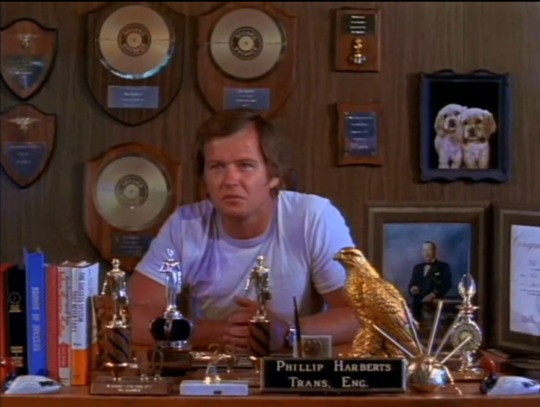
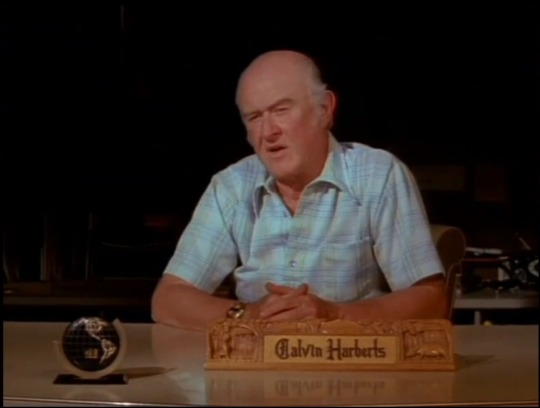

Biggie and Tupac:
I thought there was an interesting subject in this documentary, and I did like the reflexive approach the documentary took, showing us the process of making the documentary (such as seeing Nick Broomfield on the phone trying to get an interview), but I personally found that the goofy character of Nick Broomfield to be at odds with the topic, which slightly took me out of the documentary. While I enjoyed the comedy of this slightly wacky character, I felt he sometimes overshadowed the actual topic of the documentary. Additionally, while some of the voice over added to our understanding of what was happening, some of it was just describing what was happening on screen or was not too relevant (take a humorous but unnecessary metaphor about how his cameraman seemed to be on a distant island).
Overall, I am in two mindsets about this documentary. Do I think the documentary was entertaining? Yes. Did Broomfield’s actions cause other people to react in ways that revealed more about themselves? Yes. But my issue is it sometimes felt more like a parody, like a less extreme version of “I’m Alan Partridge” or “The Ali G Show”, then anything else, and sometimes I felt entertained for the wrong reasons. I feel my issue is more with Broomfield than anything else, and otherwise I do generally enjoy this type of documentary.


High School:
I liked the rather observational approach of this film and the lack of any voiceover or an interviewer, and how it just observed its subjects going about their lives. I liked the way it captured the largely mundane nature of school life, and found myself relating to the scenes being displayed. I was slightly taken out at points by the examples of continuity editing, which reminded me these scenes weren’t 100% real, but otherwise the film felt very naturalistic.
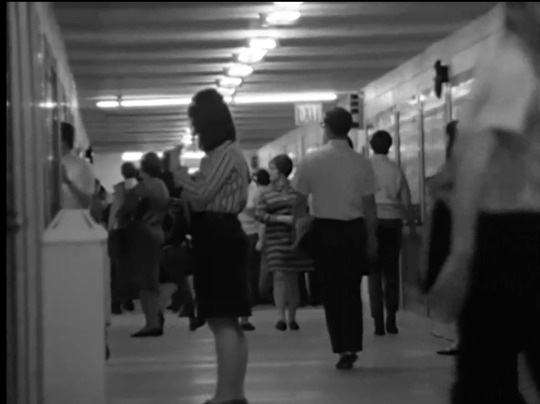
Man with a Movie Camera:
I thought this was quite an unconventional documentary, that seemed more interested in creating a sense of place and an energetic feeling than telling a story. I enjoyed the stylistic flourishes (for example, when the man is standing on top of the movie camera) and the rapid editing, and particularly likely the shots of the train rushing past. I think it created a good sense of this particular town, and touched on issues like the rising industries in Russia, the different classes and the movie making process itself. Ultimately, I’m not completely sure what this movie means, but I thought it was a very unique and thought-provoking work.
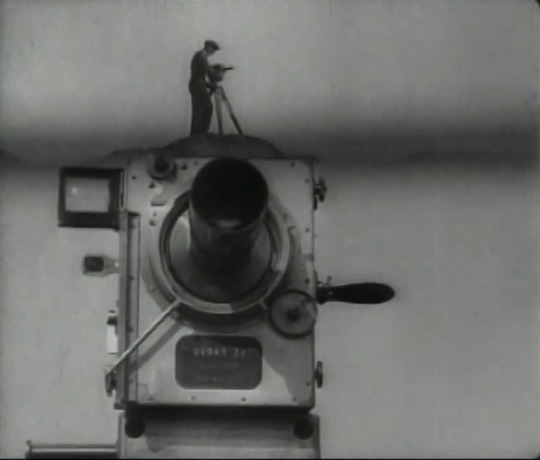
Nanook of the North:
I enjoyed the clip I watched of this movie, although it sometimes felt more like a how-to guide for building an igloo than a real reflection on that kind of lifestyle. Despite knowing the film was staged, I didn't feel this too much. Sometimes the camera felt too conveniently placed as opposed to capturing the action by chance, and sometimes it seemed like the subjects were playing up for the camera, but if I didn't know it was staged I doubt I would have suspected. I also thought the music helped to create a lighthearted, whimsical tone, which I liked.

Our Documentary (Ideas, Roles and Style):
After discussing our reservations with last week's idea, we came up with two new ones, one of which we feel very strongly about.
Idea 1:
The first idea is to do a documentary about Eden Court Theatre, a creative arts centre in Inverness, which is very significant to the local community but has been struggling during the Covid-19 pandemic.
The positives of this idea are:
With regards to filming, it is accessible to Ben and Jack
Ben and Jack already have a personal connection to this place, making them good choices to tell a story about this place (of course, I don't have this connection, but I think it's good to have one person to provide an outsider's perspective)
With lots of people having ties to this location, and my two colleagues knowing a number of these people, we would likely be able to find someone who would be willing to star in this documentary
However there is one main shortcoming: our idea is about the importance of this building in the community, but the brief states we have to focus this on a person, not a building. Of course, we can choose a particular person to focus on (someone at the top, someone who works there, or just someone like Ben or Jack who has gone there in the past), but there is the worry that, through using this person as a way to investigate this building and its significance, it may feel like the subject isn't actually the focus and we are not doing proper justice to their character, only touching on the aspects related to Eden Court. This could be avoided by generally trying to cover all of their characteristics but is still a risk. There is also the worry that our potential subjects, while being lovely people, aren't the most interesting subjects.
Idea 2:
The second idea is to do a documentary on Jack’s long time friend, Hunter.
The positives are:
With regards to filming, Hunter is accessible by both Jack and Ben.
Apparently, he is a very unique character, which is ideal for any documentary. According to Jack, he is quite a wild character with a considerable reputation in his home town of Tain, but he is also a very likable and down to earth guy, so hopefully the audience should be both entertained by him and find him to be a likable presence
Jack has approached him about the idea and Hunter responded by saying he would be up for starring in our documentary.
Jack has been friends with Hunter for over a decade, so Jack would know what is most interesting for the audience to find out about Hunter. Additionally, Hunter would likely feel more comfortable doing this documentary and would be more open around his friend. This may not be the case with our potential subject for Eden Court Theatre - while they may know Ben and/or Jack, they‘re bond wouldn't be as strong as Jack and Hunter’s is, and they likely wouldn't be as open
Hunter is well known in the community, so we would be able to get various different opinions on him
Jack has access to lots of archive footage of Hunter, which could be a nice addition to the film
Our current thinking is, since Hunter has said he will be happy to star in our documentary, and it is easier to go with him then have to find someone interesting who has been impacted by Eden Court, that is the direction we will go.
We have thought a little about roles. The thinking is Ben would be the cameraman (as he owns a good quality camera and knows how to use it), Jack would be the director and the interviewer, and I would be the editor (seeing as I wouldn’t be able to physically be there). As for the research and producing roles, these would all be shared. This isn't set in stone, but is our current thinking based on everyone's skills and where they would be in the world.
Style and Group Roles:
As for what style we would be going for, our current thinking is a mix of an observational and participatory approach. Our thinking is we would follow Hunter around over the course of his day, letting him do his own thing, with Jack accompanying him and engaging him in casual dialogue that will cause him to reveal certain things about himself (in essence, Jack is the interviewer, but is never presented as much, instead just being himself and talking to his friend). I imagine we would avoid the use of voiceover, or formally sitting Hunter down (like in “Same but Different” and “Gates of Heaven”). I imagine our style will be a mixture of “A Pigeon Game” and “High School”.
Overall, I think we have an achievable idea that everyone is happy with, and I look forward to seeing how the project develops from here!
0 notes
Text
Democracy and Development: Japan, South Korea and Malaysia
Democracy.
The most dominant political system seen worldwide in different states because of the ideals that it holds - i.e. it is by the people. In this system, the people have the right to be free, to be treated equally, and, of course, to hold their elected political officials accountable for mistakes.
However, in Asia, it is said that most democracies are flawed. Asian democratic countries follow the basic ideal however, is still lacking - hence why many see it as flawed.
Which is why for my blog, I chose three Asian countries to see how the state of democracy and development are within them: Japan, South Korea and Malaysia.
These three countries are what I consider as progressive states (despite the faults in their systems - but hey what country does not have faults huh?) and would make a great comparison.
Warning: I am not well-versed in this topic. I may have mistakes in my opinions but I am willing to be educated regarding it.
Get your reading glasses and put yourself in your most comfortable position cause we’re gonna take a while.
State of democracy and development
The data used in these graphs are from the V-dem institute who collects and analyzes data for research about democratization of countries all over the world.
For your reference, I used the V-dem online graphing tool with democracy as it’s index to show where the state of democracy lies in the three (3) countries mentioned earlier. The time period in these graphs are from 1986 - 2018.
Malaysia [MYS]
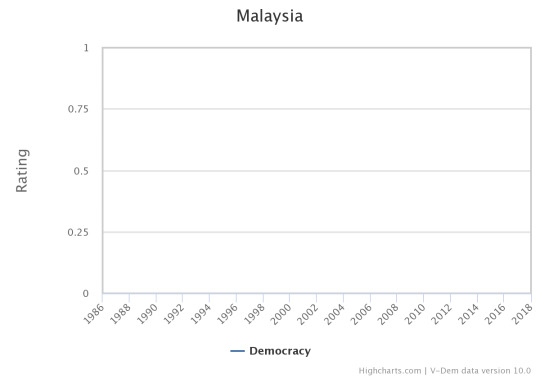
According to the data provided by V-Dem (2020), Malaysia is not in a state of democracy. The rating for the democracy index has a value of 0 which, in V-Dem’s categories, means that the state is in another political system.
Upon doing my research, Malaysia is in a parliamentary democracy which is under a federal constitutional monarchy.
Read more: https://2009-2017.state.gov/documents/organization/186496.pdf
Japan [JPN]

Although many people think that Japan is still an [imperial] constitutional monarchy, V-Dem data gives it a rating of one (1) which means that Japan is indeed a democracy as of the period 1986-2018.
I was confused by this so I did some more reading.
Upon doing further reading, in 1947, Japan put into action a constitution that superseded the Meiji Constitution of 1889. This constitution was founded on the principle of sovereignty and the goal to make Japan a peaceful and democratic country.
From my understanding, rather than someone who is in power, the emperor now plays a role of being the symbol of unity and the people of Japan. Though he does have formality roles (e.g. appointing the prime minister, chief justice), the executive, legislative and judicial branches are not in his power anymore.
Read more: https://www.britannica.com/place/Japan/Government-and-society
South Korea [KOR]
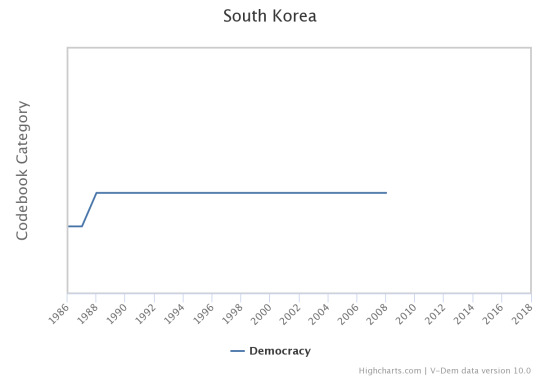
From the graph, we can see that South Korea had undergone a democratization which is a transition from another type of governance to democracy.
Again, I got curious and read more about it.
Apparently, South Korea had gone into transition to a fully democratic country by the end of the Fifth Republic where the current president by then was Roh Tae-woo instituted the democratic reforms to comply with the demands of the public. As you can see in the graph, during 1987-1988 is when this transition happened.
Read more: https://www.britannica.com/place/South-Korea/The-Yushin-order-Fourth-Republic
So, how is the democracy in these countries?
Deliberative Democracy
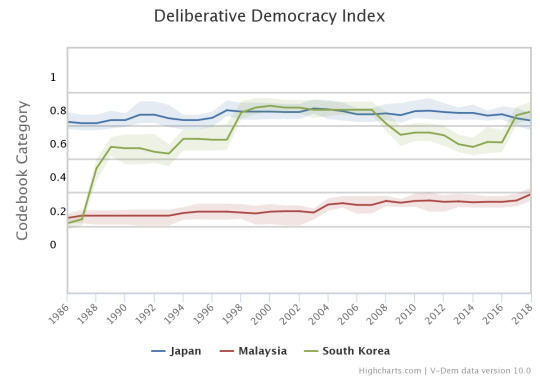
NOTE: This index discusses how the society in each country decide on their leaders. This measures how much did each member of society in this country come to that political decision. Ideally, democracy should not only be based on existing preferences but should also be open to discussion amongst informed and competent participants - a.k.a. the people should be open to opinions.
Malaysia: Taking into account that Malaysia is more of a monarchy rather than a democracy, we can understand why it was given low ratings by the V-dem. It maintained a constant of 0.2 until 2003, and gradually increased since then.
Japan: Among the three, Japan has been more deliberative compares to the other two. Although the trend is not constantly increasing nor decreasing, it never went below the 0.7 rating.
South Korea: Since South Korea underwent a transition of regime in 1987-1988, the deliberative democracy within the country increased by a lot (from ~0.2 to ~0.6+). The trend shows that although it does have some periods where it slight decreases, it has been constantly improving - by 2018 reaching a 0.8 rating for the index.
Egalitarian Democracy
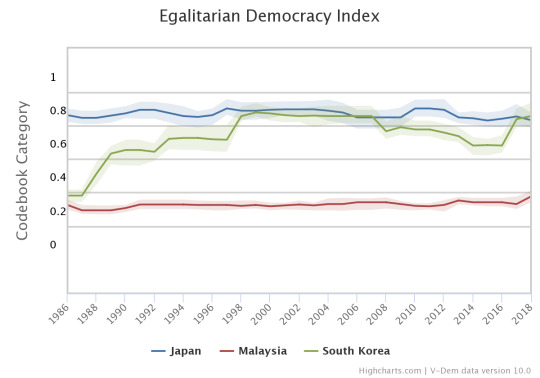
NOTE: This index seeks to measure how much equality is present within the democracy. The egalitarian principle claims that inequalities, in terms of both material and immaterial, restrains formal rights and liberties of the people and belittles electorates’ abilities (from all social groups) to participate in the democracy.
Malaysia: Malaysia’s egalitarian trend is almost like a line by the 0.2 rating. I presume that equality amongst everyone in the country is minimal and cannot be felt much by the citizens.
Japan: Japan’s trend shows that they have achieved egalitarian democracy and maintained it by having a rating not lesser than 0.7. This means that among all social groups in the country, equal freedom, access to power and resources can be felt (is that the right term?).
South Korea: From 1986 to the early 2000s, we could see that egalitarian democracy is gradually being achieved and maintained from 2000 - 2009. I guess we could say that it experienced a lapse for a few years after that but it the trend picked up from 2016 onwards (possibly from the change of presidents).
Electoral Democracy

NOTE: This index is considered an essential factor for the V-dem conceptual scheme and other democracy indices. The electoral principle of democracy is considered a personification of its core value by making rulers responsive to their electorates which is achieved through elections (or election campaigns where candidates compete).
Malaysia: The rating may be this low (although somewhat increasing throughout the years) since elections do not particularly have much power over the state’s chief executive composition.
Japan: It makes sense that Japan has a rating of 0.8 for electoral democracy since they have somewhat perfectly achieved this principle and consistently practiced it.
South Korea: Electoral democracy in SoKor is progressive and continues to improve on this principle. We can see that in 2016 onwards their rating rises - which could probably mean they are improving in terms of the criteria V-dem utilizes.
Liberal Democracy

NOTE: This index measures the liberal principle of democracy by taking into account the significance of individual and minority rights protecting it from the tyranny of the state and the majority. Government limits are the basis of democratic quality of a state.
Malaysia: We could see that liberal democracy index in Malaysia is only around 0.2 or less from 1986 to 2004 and slightly increased from 2005 onwards (though it did decrease during 2012 to 2017).
Japan: Among the three countries, Japan has constantly remained above the 0.7 rating nearing 0.8 starting from 1986. However, it had a slight decline from 2014-2015 and has remained constant even until 2018.
South Korea: In the graph, South Korea’s trend is the most unstable - whereas it has times where it constantly increases or decreases. However we can see that from 2016 onwards, the liberal democracy in SoKor has improved and hopefully continues to be.
Participatory Democracy

NOTE: This index takes on the participatory principle of democracy whereas the citizens of the state should actively participate in all political processes - be it electoral or not. This is spurred on by the anxiety felt by the people to delegate authority on a representative; hence, active participation by the public is preferred whenever applicable.
Malaysia: Though they are again the lowest rating, the significant rise during the early 2000s is maintained and gradually increased.
Japan: From observation, Japan’s citizen is considerably the most active in political processes.
South Korea: Although they were not as active as Japan in the first few years (late 1980s), South Koreans have continually became active in political processes and continue to be even in 2016 onwards (even surpassing Japan’s rating of 0.58+).
What is the future of democracy in Asia?
Although I have heard from my peers, family and friends that the democracies present here in Asia are flawed, based from the data I gathered and interpreted we could assume that democracies are more likely to thrive than fail in Asian countries.
For countries like Japan and South Korea, democracy will continue to improve. It is less likely for the democracies to fail since, by means of the V-dem indices, they show high ratings meaning they have somewhat (even if it is not perfect) achieved the ideal democracy demonstrated through its principles.
For countries like Malaysia, it may be possible that their government will be transitioning regimes (although not soon). This is only my assumption since even if it is not that big, there is an continuous increasing rating that can be seen in the graphs of Malaysia. Yes, the rates may be low but it is constantly rising and only decreasing from time to time.
That is all for now! Hope you enjoyed this post. Don’t be shy and leave an ask to discuss if you disagree with my opinion.
0 notes
Text
October 12, 2020: On Gratitude
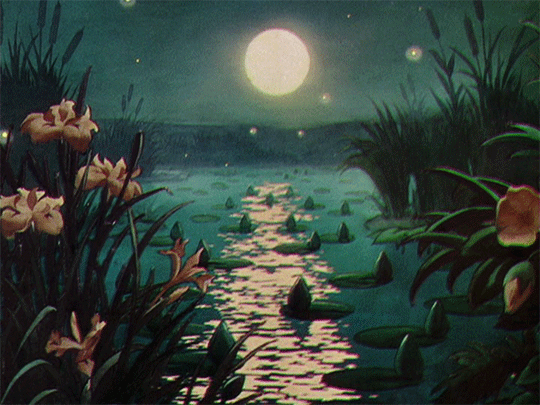
Listen on Soundcloud: https://soundcloud.com/theamcjsw/the-am-monday-october-12-2020
Stream on CJSW.com: https://cjsw.com/program/the-a-m/episode/20201012/
About an hour into this week’s episode I tried to put together some thoughts I’ve been having about Thanksgiving’s complicated past and the importance of gratitude, and because I don’t think it quite came together, I wanted to try again here. Hopefully you’ll indulge the non-musical digression.
First of all, for a bit on the history of Canadian Thanksgiving, this Macleans piece offers a well-written summary. The short of it is, there isn’t a single clear point of origin, and there are connections to indigenous harvest celebrations, Puritan days of Thanksgiving, Christian proselytizing, broken treaties, and self-serving myths, all of which make unquestioningly celebrating the holiday a difficult thing to do.
On the other hand, a day devoted to gratitude, separate from the history of Canadian and American Thanksgiving, is a good, healthy, and maybe even essential thing. Kahsto’sera’a Paulette Moore and Tehahenteh Frank Miller write in great detail about the importance of gratitude in their culture (both describe themselves as Kanyen’kehaka Mohawk, Six Nations of the Grand River Territory), and although a few things from that piece struck me, what hit me deepest was the notion of gratitude as a redemptive and reconnective practice.
They describe a dark time in their culture's history, where they were at war with each other and disconnected from their lands, which was only overcome after they were reminded of the gift of gratitude. “Our ancient practice of thanksgiving saved us time and again from the devastation of a world out of balance,” they write. “We were fearful and greedy, hoarding resources and extracting life and energy... Over time we were able to achieve what seemed impossible; we re-engaged simple acts of thanks, which led to healed relationships. Eventually we united as the people known as Rotinonhsyón:ni/Iroquois – a confederacy that remains the oldest participatory democracy on Earth.”
On the BBC News this morning, there was a report on a study promising a bleak future for humanity if we (meaning the world, but really meaning industrial nations) continue on the path we’re on. It was an eerily direct echo of Moore and Miller’s writing of their Nation’s past before rediscovering gratitude and the connections it nurtures. As in their example, practicing gratitude won't be an instant fix—it's an ongoing practice that leads to incremental change—but it may be at least part of the answer.
I ended this week’s episode by trying to show some of the gratitude that I feel for my community and the land I live on—and found it was surprisingly awkward to do. Expressing gratitude is vulnerable and bringing it up on air felt hokey, and somehow embarrassing. Afterwards I tried to figure out why that was, and I think it’s because it cuts against the grain of self-sufficiency that’s so deeply inherent in Western culture. To understand how, it helps to think about when you do and don't express gratitude. You don’t say thank you for something you did for yourself, so to be grateful for something is to say that you are dependent, or even subservient to whatever provided it. You don’t say thank you for things that are inevitable, so gratitude is a reminder that the things we value most are contingent and temporary. Both of those are vulnerable admissions.
Gratitude also implies a debt of sorts, although not in the same sense that a bank loan creates a debt, where there’s an obligation to repay exactly what was given. That's a transaction, and we don’t really feel gratitude for transactions, for bank loans or purchases where we spend an amount equal to what we received. But it’s not about getting more than we put in, either. We don’t feel gratitude just because we got the better deal. Instead it seems to be about the relationship a gesture implies, and the obligation it creates isn’t to even the accounts, it’s to create more gratitude, by doing the sorts of things that others can be grateful for. In that way, the debt gratitude creates isn't owed to any one person, it's owed to everyone—and when repaid, it grows exponentially.
One last though. Last month I was on the Sunshine Coast in BC, and there was a hiking path I walked on at least three different days. Every time, it was jaw-droppingly beautiful. The last time I walked it, as I was leaving, I felt the need to thank the path for those experiences--to literally say thank you to the woods for the beauty and calm it had given me. I don’t believe there was anything there, spiritual or otherwise, that could hear me and understand what I was saying. I did it because I liked the relationship it created between me and that place. Rituals of gratitude are about connection, but they’re also about your own internal attitudes, and the relationship you want to have to the world. And because of that, Thanksgiving—the concept, if not the holiday—is one of the most profound rituals we have.
Playlist is below, if you’re curious.
Hour One:
City of Mountains
Various Artists, featuring Christa Belle • AUDIO: An Experimental Noise Compilation
Dream Rain
Stilz, Ian Urbina • Forgotten Shores
Nashville
Various Artists, featuring Ryan Hemsworth • EVER NEW
Cholorophyl Sunset
Proxima Psychoacoustics • Kaznmward
Friends in Secret
CRi • Juvenile
Long Road Home
Oneohtrix Point Never • Drive Time Suite
Landstrasse 2020
Hainbach • Assertion
An Elephant on Your Eyelid
The World Next Door • Single
Search for Peace
Various Artists, featuring Ishmael Ensemble • Blue Note Re:Imagined
Thank U Malcolm
Flying Lotus • Flamagra
Streetlights
Buildings and Food • Up Down Strange Charm
Theme from the Cinematologists
Gwenno • Podcast theme
Taking the Present for Granted (Traffik Island mix)
Bananagun • Single
Hour Two:
Rivers That You Cannot See
North Americans • Roped In
Thank You
Brainstory • Buck
Stop and Listen
Peter Broderick • Blackberry
All That Love in Your Heart
Bastien Keb, featuring Claudia Kane • The Killing of Eugene Peeps
Heavy Metal
Cindy Lee • What's Tonight To Eternity
Breathe
SUUNS, featuring Jerusalem In My Heart • Fiction EP
Sleep
Godspeed You! Black Emperor • Lift Your Skinny Fists Like Antennas to Heaven
Hour Three:
Brokenhead
Zoon • Bleached Wavves
Sequel
Various Artists • AUDIO: An Experimental Noise Compilation
Corsican Shores
Deradoorian • Find The Sun
Never the Bride
Raf Wilcot • Cinnabar Bouquet
Avalanche
The Notwist • Ship
Radiation
Various Artists, featuring Dark Time • The Sled Island Lemonade Stand Vol. 1 & 2
Ocean City
Gunn-Truscinski Duo • Soundkeeper
Sunlight is Collecting On My Face
Dixie's Death Pool • The Man With Flowering Hands
The Uncertainty Principle
Heliocentrics • A World of Masks
Sweet Path
Janko Nilovic, The Soul Surfers • Maze of Sounds
Awoke in the Early Days of a Better World
Andrew Wasylyk • Fugitive Light And Themes Of Consolation
0 notes
Text
Insights on Development Communication
New Insights
Upon reading Terms and Definitions in Communication for Development and Social Change by Jan Servaes, Development Communication Primer by Nora Cruz Quebral, and Development Communication: Communication for or of Development by Dr. Mrinal Chatterjee, I ended up with various insights and critiques.
In Servaes’ reading, I was introduced to the concept of Development Communication and Communication for Development. Admittedly, I had troubles differentiating the two at first but upon reading the entire article, I was able to come up with a simple working definition that made things clearer for me, and hopefully for you too. Development communication is the process of communicating with a goal of development in mind, while communication for development is the social process that seeks common understanding. In other words, Development Communication is the act of disseminating development techniques and strategies through communicative mechanisms, while communication for development is a two-way communication system aiming for development that paves the way for dialogue and participation of both parties.
My main takeaway from Quebral’s primer is that Development communication focuses on developing countries however it is hard to tap into rural areas because they still rely on media such as radio and newspapers. Understanding Amartya Sen's "Development for some may cause underdevelopment for many" will allow people in media to recognize the gap between the rich and the poor because mass media technologies are considered as “magic multipliers” of development. By doing so, we can hopefully create solutions that will be able to target both parties as communication is the vehicle that carries development onward, and we can't consider a country or a nation to be developed if some are left behind.
And lastly, for Chatterjee’s article, the concept of development communication was discussed in-depth on how it is used as a medium for behavior change for the masses. Disseminating information, listening to feedback, and responding appropriately is essential in having meaningful communication for Chatterjee. Development here is not just in the ideological sense, but tangible outputs which will lead to actual development in the future. Through this, consensus will be created to raise public understanding and generate dialogue among stakeholders. Stakeholders here are the government, civil society, and the media, who all have different goals and objectives for communication development.
Common Themes Present
After reading all the three readings, I was able to relate Communication of Development to the concept of Participatory Development from one of our Development Studies major classes as it enlists both local knowledge and local participation. I also understood development as a highly contextualized concept because it is seen as a reflection of personal values, and the standard of development is dependent on the societal framework. Lastly, the importance of media in development communication was also discussed in all three readings. Servaes explained how the use of traditional and non-traditional media should not be seen in isolation from another. The blending of media is a way for a message to have a wider reach and for the mass to receive the benefits from both media. Quebral and Chatterjee discussed how the use of both media would be highly beneficial for educating people and propagating development ideas and strategies to the mass. Through this, I was able to understand the importance of recognizing the lack of development in some areas and their preferred media for communicating with other stakeholders. For example, Servaes and Quebral discussed traditional media such as radio and newspapers are more accessible for these people compared to non-traditional media such as digital, mobile, and social media.
Difficulties
The concept of information and communication technology considered to be more personal and affordable confuses me because how can it be if it only widens the gap between those who can afford the new/modernized mass media and those who cannot?
0 notes
Text
NOT COUNTER BUT PARALLEL (Excerpts from Light Leaks 1 2018)
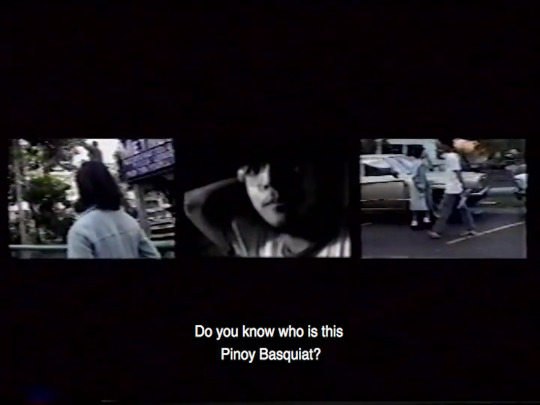
2018 was an extremely busy year for Green Papaya. Somehow, between preparation work with VIVA ExCon Capiz 2018, Papaya still managed a collaboration with Los Otros, “Light Leaks 1: Tracing histories of Philippine experiments with the moving image” which was hosted by Yael Buencamino at the Ateneo Areté on September 12, 2018. Light Leaks developed from the research that started with another Papaya-Los Otros collaboration, the Kalampag Tracking Agency, a screening program and accidental archive of Philippine artists’ moving image that started in 2014.
Among the discussants and panelists for Light Leaks 1 were curator Clarissa Chikiamco, artist Pandy Aviado, and then NCCA Commissioner Teddy Co. Screenings included the cult short film Tronong Puti (1983) by Ted Arago and Roxlee, Philippine indie cinema documentary Beyond the Mainstream (1986), and a surprise preview of Rod Paras Perez's Conversation in Space (1962) courtesy of Odel Perez.
Coinciding with the current edition of Light Leaks at MCAD Platforms this month we are posting below the opening remarks made by artist and filmmaker Shireen Seno of Los Otros and an excerpt from the Q&A.
*****

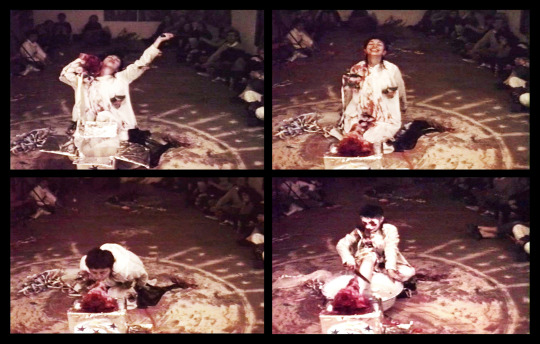
Introduction:
Shireen Seno (SS): Philippine moving image practice has a history of pioneering experimentation, but because of this very experimental and uneasily classifiable nature, not much is known or published outside of its more popular iteration: cinema.
Light Leaks is an attempt to piece together these disparate and mostly oral histories by convening a series of forums that consist of research presentations and focused discussions with key artists, curators, researchers, and cultural workers across generations. Along with key historical texts and newly commissioned essays, the proceedings from this symposia will lead towards publication that will hopefully inspire new generations of scholars and practitioners.
This first edition of Light Leaks focuses on a general overview of practices from the ‘60s to the ‘80s in Manila from the personal accounts of Pandy Aviado and Teddy Co and the ongoing research of curator Clarissa Chikiamco.
In her essay “Otherwise Video: Development of Video Art in the Philippines in the 1970s,” Chikiamco states, “When we talk about the development of video art, I believe it is important not simply to consider artworks which use video, but artworks which anticipated video art works. By that, I mean art works which foreshadowed art works that actually used the medium of video. These artworks, forerunners to video, may not have used video but we can name certain qualities which have overlapping identities with the video medium. In particular, these qualities are movement and time.” These experiments paralleled movements in the US and the UK with expanded cinema, installation, and performance. Starting in the ‘60s, expanded cinema practices featured artists moving away from the screen and finding creative ways to project and intervene with moving images. The emergence of video, and later digital moving images, opened new possibilities concerning what artists could do and what moving images could be.
I quote from Kim Knowles’ book Experimental Film and Artists’ Moving Image: “Existing outside the boundaries of mainstream cinema, the parallel fields of experimental film and video art present a radical challenge, not only to the conventions of that cinema, but also to the social and cultural norms that it presents. In offering alternative ways of seeing and experiencing the world, they bring to the fore different visions and dissenting voices. In recent years, scholarship in this area has moved from a marginal to a more central position as it comes to bear upon critical topics such as medium specificity, ontology, the future of cinema, changes in cinematic exhibition, and the complex interrelationships between moving image technology, aesthetics, discourses, and institutions. This series takes on exciting new directions in the study of moving image practice, from the black box to the white cube, film to digital, crossing continents and disciplines, and developing fresh theoretical insights and various histories. Concerning the terms “experimental film” and “video art,” we see these as interconnected practices and seek to interrogate the crossovers and spaces between the different kinds of moving image-making. Finally, we acknowledge the emergence of a new term—artists' moving image—in which to situate the most recent generation of filmmakers and artists alike who work with the moving image.”
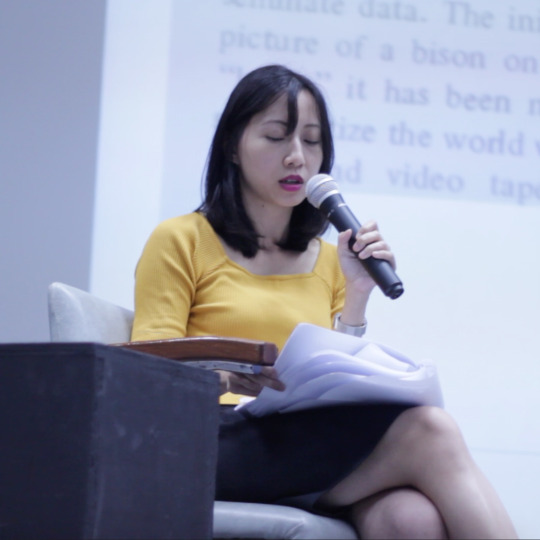
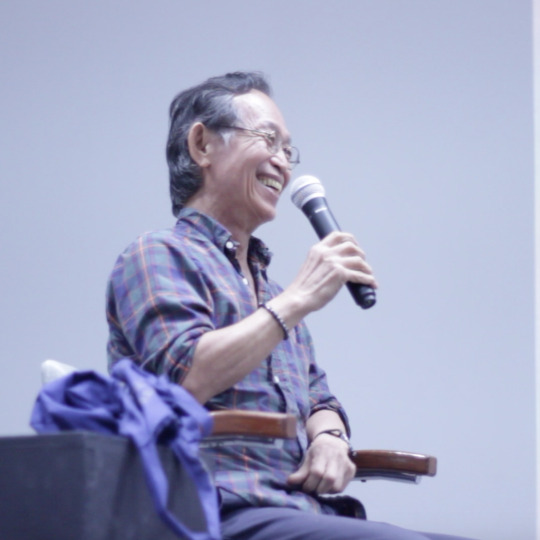
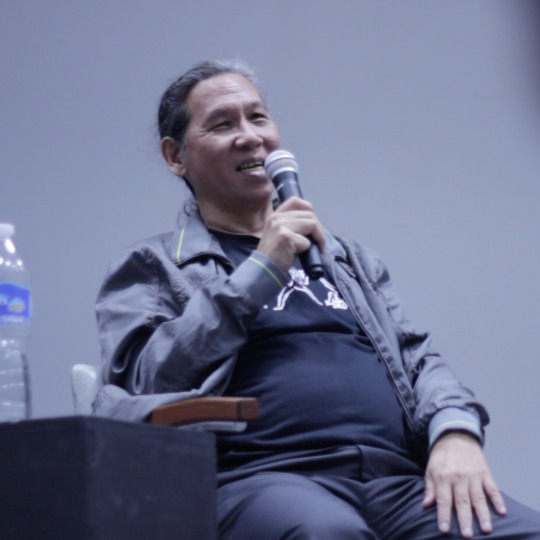
Q&A excerpts:
Merv Espina (ME): I’m gonna read a question, this is being live streamed so some people are watching us online. I think this question is for all of us: “Since the program is framed under the development of video art in the Philippines and while most works within the oral history presented focus on experimental, avant garde, performative, and materialist films all rooted under the notion of expanded cinema, how do the curators see them as a kind of anticipation to our present concept of ‘video art’ and what could be the basis for categorizing them as leading to video art or into this more expanded category of artists' moving image from the rest of other experimental films done during that time?”
Teddy Co (TC): That’s an interesting question.
ME: From Cocoy Lumbao.
TC: Okay, Cocoy. All art is evolving, nothing is static. Because if anything remains static, it will die and no one will want to practice. The language of art, of the moving image, is developing. There have been high points and low points but it moves forward and to categorize all these video images under video art, maybe that’s a bit too narrow because it’s really expanded. Some people have said that the better word to use is not “experimental” or “video art” but maybe something more like “expanded cinema” because we’re getting into all kinds of forms, content, and platforms. On the internet, on the big screen, in virtual reality.
We’re living in very exciting times because it’s so diverse now and technology has leapt forward. Before, it was all flat. Now we have 3D, there are a lot of participatory and interactive elements with the works now, and also, the disciplines are getting together. For example, there’s a lot of dance programs now incorporating video creatively. Tad [Ermitaño] has collaborated with Denisa Reyes to produce some works. The dancer-choreographer Rhosam Prudenciado has collaborated with Annie Pacaña who had all these videos of telephone poles and then she had two dancers do a ballet across the poles. You’d think they’re on the telephone lines but that’s a video. I hope that answers the question.
ME: Also, since Johnny Manahan was mentioned earlier, there were also some collaborations between him and the Cultural Center of the Philippines (CCP) dancers and Ballet Philippines, even using overhead and slide projectors around that time.
TC: I saw one performance but it’s by a foreign dance troupe in the CCP back in the ‘70s or ‘80s in which they did something—what we would now call “video mapping”—using slide projectors. They projected slides on the dancers’ bodies who were wearing skin-colored suits.
Clarissa Chikiamco (CC): Hi, Cocoy. I find the question very interesting. Even when I was writing my paper, I have to admit that I was also struggling because, if I were to expand simply on video art, you would be looking at all these other impulses. I was thinking, “where do you stop?” It just becomes this really large body of work. I’m sure when we continue to do research, even more will be uncovered. Even just the idea of categorizations, at that time, maybe artists were not really concerned with it. They were just doing these things. Artists alongside filmmakers maybe didn’t classify themselves and their works in a particular category. They were just making work. And somehow, decades later, we are trying to make sense of these things. We’re trying to fit these things into certain boxes or even break them apart. Where do you stop from here? This is also an ongoing question that I have.
ME: I’ll read the follow-up question. “In situating these diverse forms under the more encompassing category of artists' moving image, I just want to open the question on whether there might be a kind of “counterproductiveness” to research if these diverse forms are not explored under their own stream of either being under essentially cinema or film practice, or video being under the technology or tradition it was originally made like broadcast, VCR, video recorders, etc?” Do you want to react? Is it counterproductive?
TC: Well, I don’t think it’s counterproductive. I think we should discuss, talk, and exchange ideas. That’s why you have a forum like this, you have a panel. It’s very healthy to talk and discuss. It’s unhealthy to not talk and to shut up because that’s a different kind of atmosphere. Like I said, the whole thing, the whole movement or whatever, would have been much bigger if there had been a proper community of people who exchange ideas, people who read and would say, “Why don’t you read this book?” or, “Go to that screening” because a lot of these things were done in isolation unlike today.
Today, since you have social media, ideas spread so fast. Will we reach a saturation point? I don’t know. Things evolve, like I said. Not to put things into boxes like, “this one’s visual art, this one’s cinema” because things mix. They intermarry and there’s a lot of fusion going on, even and especially in food. If we just stick to our native food, we will be stuck with lechon. But there’s a lot of creativity in the food scene now, right? Because there’s a lot of fusion and intermarrying. Culture and art are like that.
I think that has been going on especially now because we’re a wild world. As [Marshall] McLuhan said, we’re in a global village. Of course in some territories, some people would say, “We have too many film festivals now, we have too many films.” But would you like to go back to 2004? We had nothing but the Metro Manila Film Festival. It used to be like that. Just that, every December. Your choices were limited to Vice Ganda or Vic Sotto.
Don’t take the market of ideas and the freedom that we have for granted. Last year, at the Yamagata International Documentary Film Festival, I met this Chinese filmmaker who made a film about the last independent film festival in China that was closed down by the government. They don’t have a Cinemalaya or Cinema One. They have nothing like that. We have to learn to appreciate all of this, all of the institutions that are helping us put up all these programs even with a President like that. There’s a lot of open and free space.
ME: In response to Cocoy, I think—at least for this series of forums and discussions that we want to convene, focusing on Philippine experiments in moving image practice—we’re essentially looking at works that were hard to categorize. We should re-examine these materialist considerations of works in film or video and also look at works that have fallen in between the cracks—and there are many cracks. Some of the works mentioned today fall outside major art and film histories so what we’re trying to propose is that we need space for more narratives, histories, and maybe not look at particular materialist media, film, and cinema-specific narratives. This is not counter but parallel.
*****
These excerpts have been edited for length and clarity. Some parts were translated from Filipino.
Watch the archive of the 2018 livestream:
https://facebook.com/events/s/light-leaks-1-tracing-historie/317775908984451/
*****
The current edition of Light Leaks is now live.
Watch early works by Lena Cobangbang:
https://bit.ly/MCADPlatformsCobangbang
Register for the discussion:
https://bit.ly/MCADPlatformsEE
Sep 9-15 Screening: Lena Cobangbang, works 1997-2002
Sep 12 Discussion: Lena Cobangbang with Eileen Legaspi Ramirez
Sep 16-22 Screening: Katya Guerrero, works 1990-1992
Sep 19 Discussion: Katya Guerrero with Cocoy Lumbao
Sep 23-30 Screening: Jean Marie Syjuco, works 1986-1992
Sep 26 Discussion: Jean Marie Syjuco with Clarissa Chikiamco
*****
1. The Salenga Experience (2002), Alice & Lucinda (Yasmin Sison and Lena Cobangbang), video still
2. Untitled (1990-1992) Katya Guerrero, video still from 16mm transfer
3. Signed, Sealed, Delivered (1989), Jean Marie Syjuco, video documentation, Performance Space (Sydney, Australia), photo courtesy of ART LAB: Atelier Cesare and Jean Marie Syjuco
Images from Light Leaks 2018 at Ateneo Areté by Yuji de Torres:
4. Lisa Chikiamco
5. Pandy Aviado
6. Teddy Co
If you can:
https://greenpapaya.art/donation
0 notes
Text
UPDATE - CHANGE OF PLANS, COVID-19
Upon my return to Suffolk, to install the artwork in the garden. Lockdown happened .
Unfortunately it has meant the project can't be installed
my project proposals for the space and I think that the individual circles will look for impressive than one large board. Which will create an installation, the staggered pieces will encourage movement through the space and therefore some exploration of the space. As opposed to focusing on one singular point e.g a singular mural.
7 circles, preferred shape in spaghetti painting workshop were circular stamps.
7 colours of the rainbow ( ROYGBIV) substituting Indigo for pink as pink was popular amongst nearly all if the early year girls and was chosen more than the dark blue paint in all experiments.
7 insects based off their preference in colors and some mentioned in the getting to know you questions.
Patterned and colorful to engage and distract a busy mind.
Unfortunately, due to the Corona virus pandemic the project at the primary school has been postponed. I returned to Suffolk on March 17th to continue the project for a week and assemble everything in the garden. However, I was unable to visit as now of course the country is in lock down and schools were soon after closed. Despite this most of the artwork is here and complete. I had previously got circles of ply board cut at a local DIY store after completing the first workshop with the children.
As an alternative the artwork will be temporarily displayed to create this well being garden as an installation in my own back garden. The garden I created was using the resources I had available. The circles needed completing, they were painted in a combination of emulsion, acrylic and decorated with both acrylic and permanent markers for additional focus to detail.







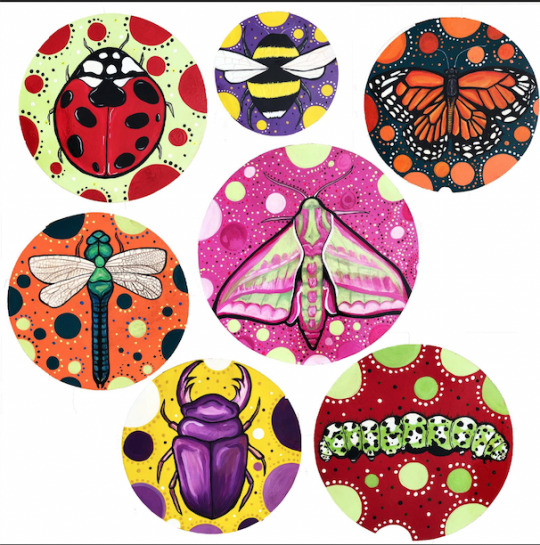



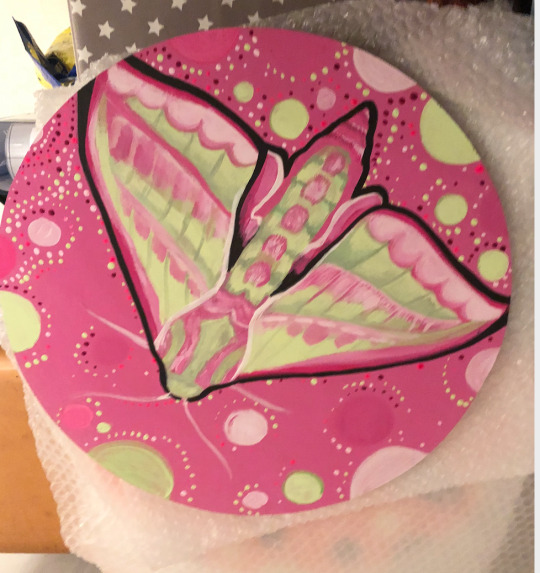

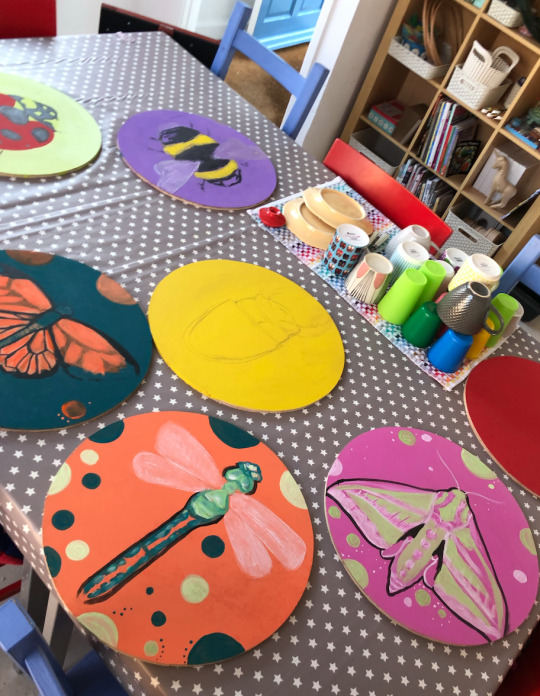
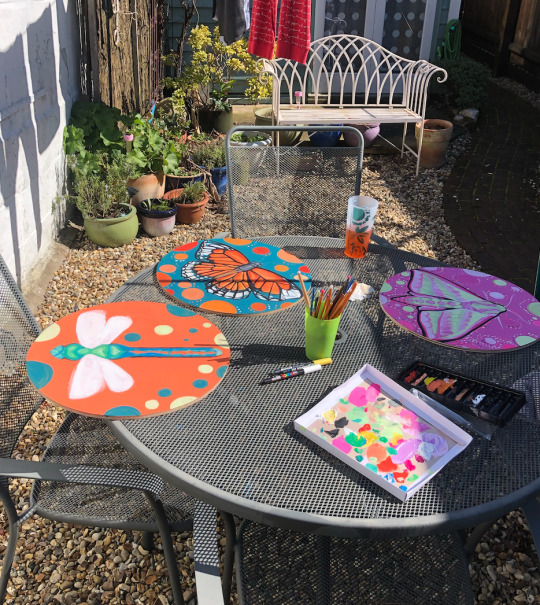
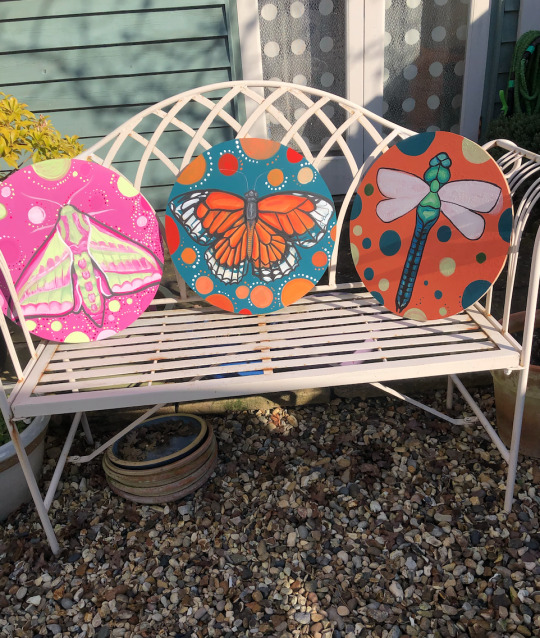
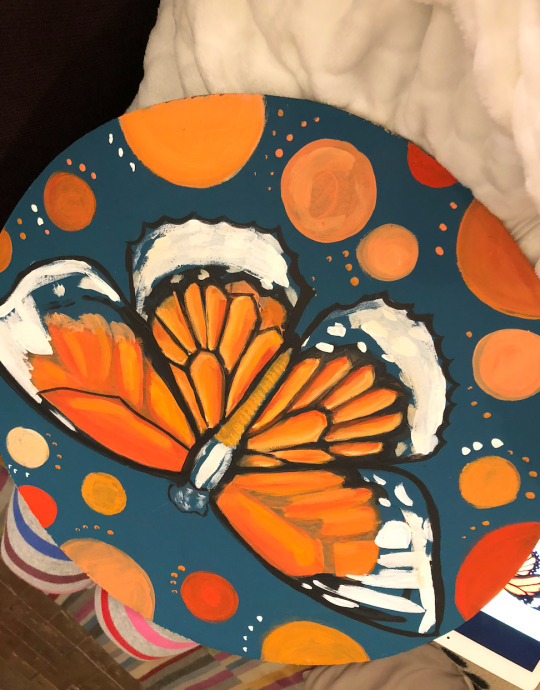

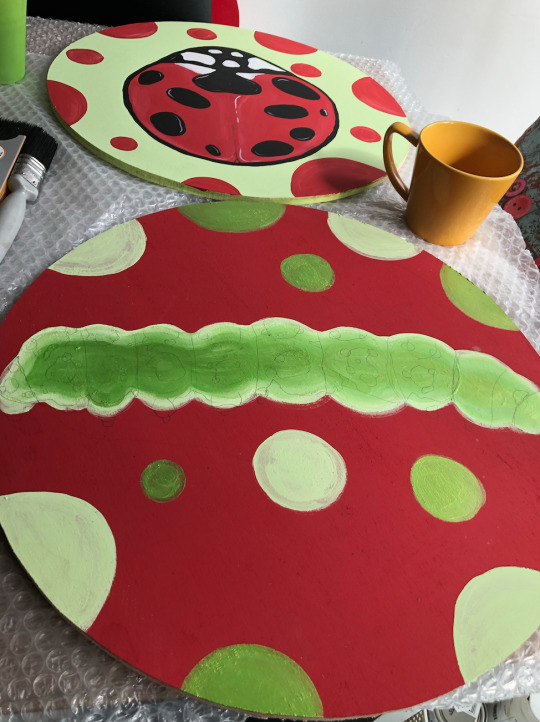
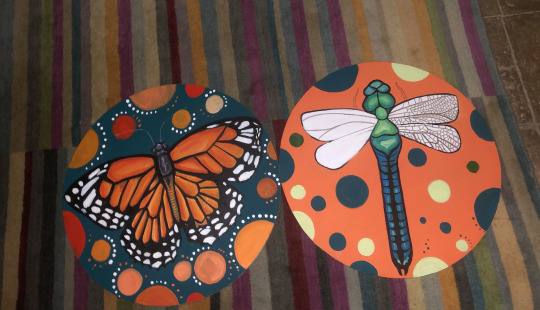
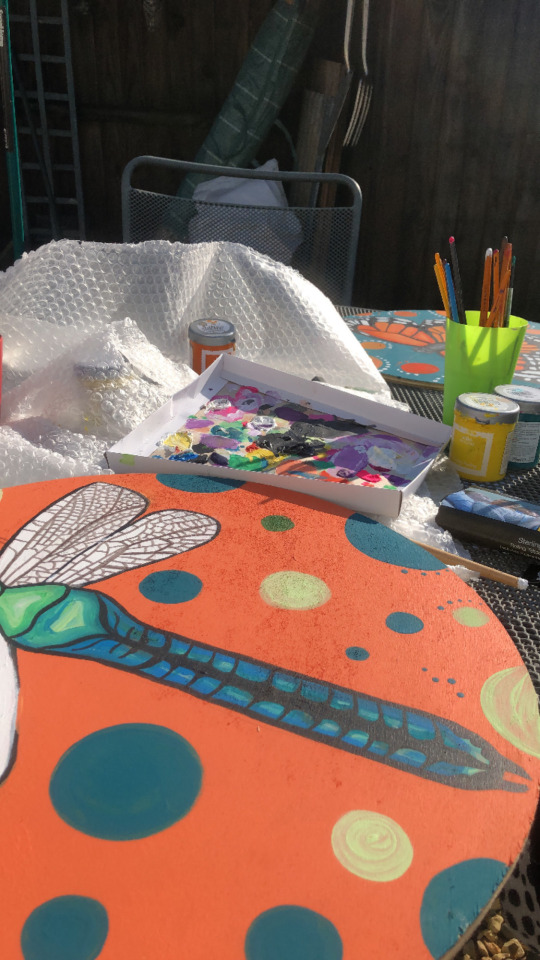

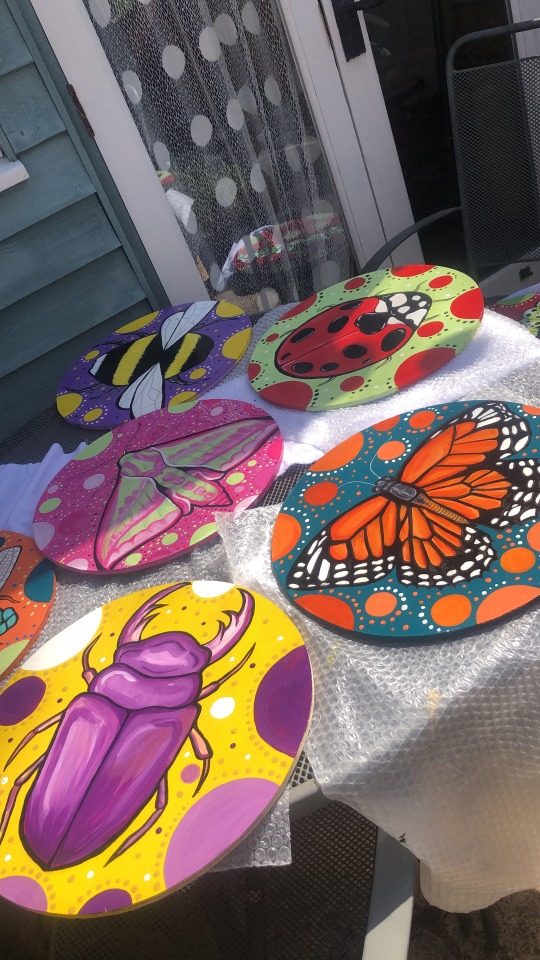
My intention was also that the garden had participatory elements. Despite not being at the school, luckily the play and participation workshops were completed prior to this. Using the stones the wellbeing walk was created in my own back garden which is a collaboration with all the early years children and the eco club at Worlingworth.
Furthering this, I intended to add more participatory elements but did not have access to communicate with the children during lock down. As an alternative, I asked my family members to help me to make some more of the created textural elements I wanted to include; as touch is a very stimulating sense. So added pom-poms and knitted bunting which are soft and gentle to the touch. My great grandmother lovingly made the knitted rectangles, and my little cousin made the pom-poms.
Despite the disparity in age, it still showed major engagement and also kept them busy in a time of boredom and uncertainty. Florence, would ordinarily be at school playing with her friends and is quite an unusual unsettling time for her. Where on the other hand my great nana is 89 is retired and lives quite remotely anyway. Despite this is more isolated as she is unable to have all of our family visit and keep her company. During this time in lockdown, I intended this element of the project to be mutually beneficial. To help contribute to my garden with extra addition of participatory elements. But also to keep them occupied and also give them a sense of achievement that they are part of and contributing to a project outside of their home to hopefully combat feelings of loneliness during isolation. Creating is also good for wellbeing, as well as, being a good way to fill time. INSERT QUOTE ON CREATING AND WELLBEING.
I collected them from outside their gates and observed social distancing measures.
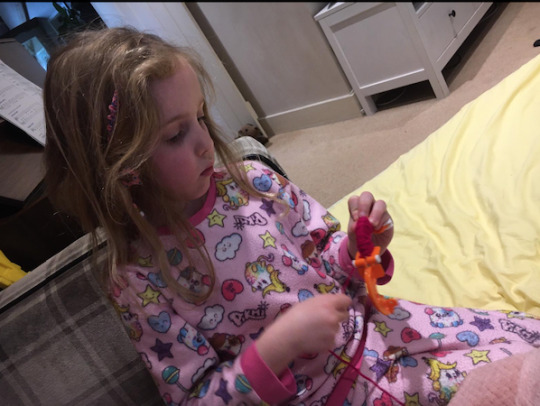





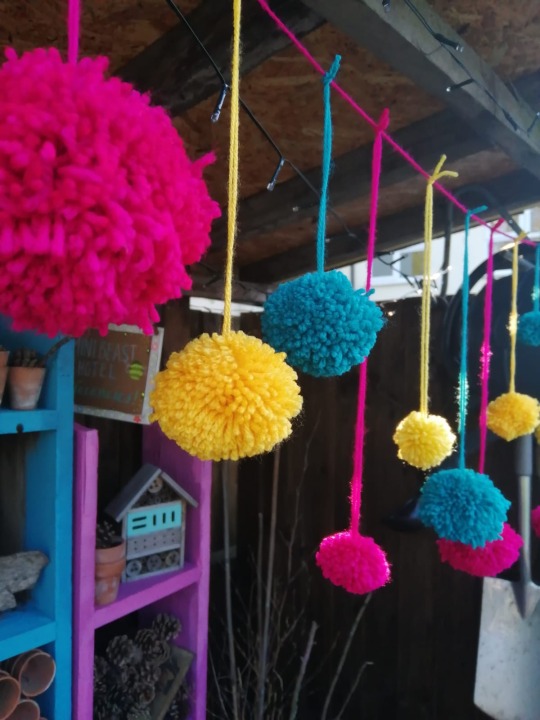

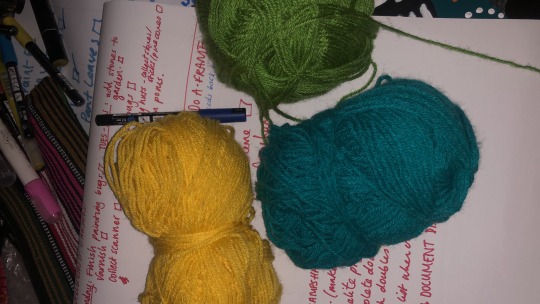
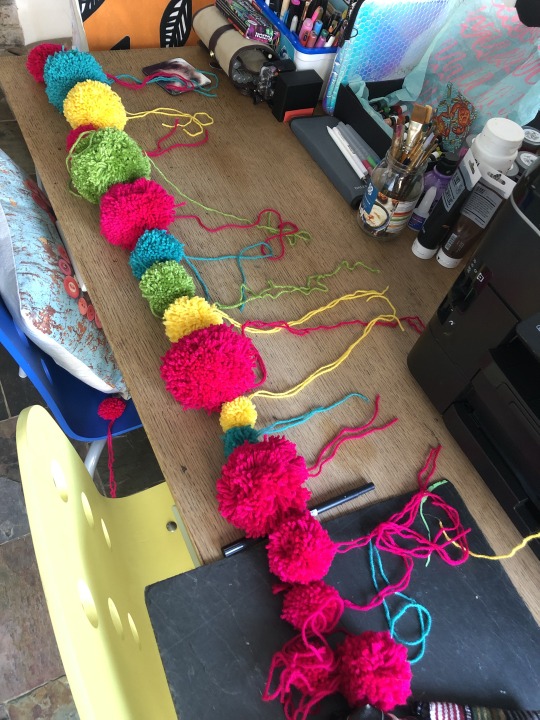
In addition to this, the ability to create the wellbeing space in my own garden has meant more freedom in terms of what I can create. No limitations to the schools request meaning I can better utilize the research that I have found to help improve wellbeing.
As an example, I plan to create a sensory corner.
MAKE A MINDFULNESS CORNER 78
“ mindfullness is the practice of focusing on the present while acknowledging - but not being overwhelmed by - thoughts and emotions”
“A form of meditation, it is encouraged health professionals to help with conditions such as anxiety and depression, but can aid anyone seeking peace of mind. If you’re designing your garden to reboot your brain, making a mindfulness corner helps to enhance effect”
79- “Place a comfortable seat with its back ti a wall, fence or hedge to foster a sense of security then partially enclose the space with vegetation to filter out buildings or street areas. As well as any anxieties associated with them. you can do this in a garden or on a balcony”
“Tune into nature, include water and nectar rich flowers around your seating to lure bees, butterflies and other pollinators to your mindfulness zone. Their movement and gentle buzzing sound will engage your senses and help you to focus on the present. /surround your space with green and flowering plants with patterns and colors that please you”
brain processes the complexity
79 “ choose plants whose scents that you enjoy and engage your sense of touch by selecting tactile plants (lambs ears) that you can stroke.”
“Add some lavender, rosemary or your particular favorite fragrant plants to stimulate your sense of smell. A fascinating sensory corner that offers the soothing benefits of mindfulness will give you the ultimate brain reboot”
92- senses “ potent and emotive influence on us, but it can also have therapeutic qualities”
“a person takes 23,000 breaths a day and some studies suggest we can detect more than 1 trillion odours’
“The human nose contains around 400 different types of affecter receptors, which detect odors in concentration as lock as 1 part per billion”
I can also create more things with the additional space and time which would be beneficial in a wellbeing garden
0 notes
Text
Fernweh and Heimweh: Week 23, Spain
Straddling the line between Fernweh (wanderlust) and Heimweh (homesickness) as we continue our life in Spain. It’s been another week not (yet) on the road, with life here in Corbera made more delightful by a series of social outings including the launch of my exhibition In Valencia, ‘Stop Making Sense’.

What a funny week we’ve had. This week has certainly seen some big changes, as we finally made it out (three nights in a row) into Valencia to catch up and hang out with people after months of social isolation. It’s also been a week where I’ve been a bit lost in my own mind, thinking about the bizarre situation I find myself in, somewhere between ‘Fernweh’ and ‘Heimweh’.
I first heard these two German words from Charles Landry, an author and speaker who specialises in cities and the topic which his name has almost become synonymous with, ‘Creative Bureaucracy’. I saw Charles speak as part of the States of Change Learning Festival back on the 20th June, in a session about the roles of public imagination versus bureaucratic creativity when it comes to culture change. Because it was an online festival, the beauty of the session was the sense of intimacy you got from seeing Charles and the other speaker, the wonderful Anthea Lee, discussing the topic directly over Zoom, and them answering the questions from the participants directly using Zoom as a conduit.
Charles introduced his own tangled sense of place and identity, and referred to the words Fernweh and Heimweh, which mean ‘wanderlust’ and ‘homesickness’ in German. Charles’ description of this strange kind of yearning struck a chord with me. Having left home to go to uni in Newcastle at 17, moving to Australia at 21 and then returning to the UK at 24 to build a van to try to travel the world in, I have certainly felt a similar tension: a strange kind of desire to be both uprooted and rooted, on-the-move and grounded in one place.
I guess this tension between wanderlust and homesickness is what drives many people to travel a lot while young, before ‘settling down’ in later life.
But the strangest thing about this tension (and something which I’ve observed increasingly in lockdown) is the nonsensical desire that I have to have both at the same time. Of course, that’s completely impossible. You can only be in one place at any given moment, and so that can either be off galavanting and exploring new places, or building roots and a sense of community in the place you call ‘home’.
One of the inadvertent results of coronavirus for George and I however, has been getting ‘grounded’ here in one place not long after we set off from the UK. In this sense, it feels like the worst of both worlds, not getting to travel the open road as we’d planned for so long, and also not getting to live in a community, near friends and family we know and love in a house of our own.
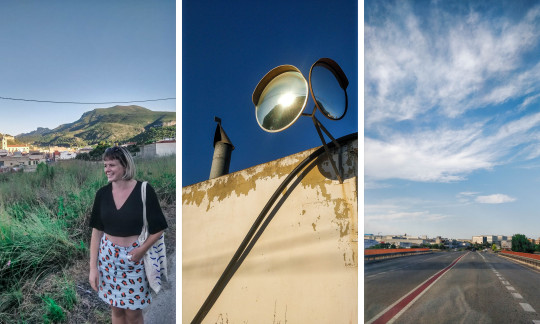
(images, left to right) Exploring hidden pockets of Corbera, enjoying odd little photo-ops, and yearning for the open road.
Of course, this really is a ‘first world problem’, but it’s also been an emotion I’m keen to explore in myself, as I feel like it’s always been there even before the pandemic struck. What is it about the desire for diversity that drives travellers like George and I out of our comfort zones, away from our dearest friends and into the unknown? And is the pain and sense of disconnection, the lack of financial security and yearning for the roots of community really a worthwhile price to pay?
When I’ve aired my doubts about our travels to friends, they often reply with “but you can’t do that, you’re living the dream!”. And I’m left thinking, “Am I? Is this the dream?”
I guess these exchanges have made me question what we put on the line for our ‘dreams’: imagined perfect futures which embody the values we want to live by and the lifestyles we want to enjoy. It’s not that I’m not enjoying my life right now (even though it certainly doesn't look anything like what I expected), but it’s that I’ve been genuinely questioning the pay-off between the different dreams that I want, and the pain that has to be endured to get there, which in some ways is the pain of having Fernweh but not Heimweh, or having Heimweh but not Fernweh.
This idea of our ‘dreams’ has been making me think about the future. I’ve always been interested in the study of the Future, not just in terms of predictions and projections but in terms of imagining alternative outcomes and utopias. In fact, I interviewed the wonderful Futures Thinker, Mansi Parikh, a month or two ago for an upcoming video and it’s a topic I continue to get drawn into. All that said, living life amid the pandemic has reaffirmed in me the importance of being present, and finding ways to enjoy the here and the now (something I wrote about back in Week 16’s post).
It seems that Western culture’s fixation on the future can in many ways lead to unhappiness in the present, despite the irony that the time we only ever experience is right now.
With that in mind, I’ve been trying to draw my attention to the here and now. I find the only way to curb my sense of isolation from friends or my sense of frustration at not yet being able to resume our travels has been to focus on the small things that make the everyday good. I guess what I’m effectively talking about is gratitude, and realigning awareness to the positive things that we forget to see. Often those small things, even if unplanned, are the things which make life worth living, which can give you a sense of wanderlust or a sense of home too.
So I’ve been noticing the sunshine. The way the heavy air falls around 2pm here and the siesta brings the village to a sleepy lull. I’ve been noticing George. The way he doesn’t get bored of my jokes and (amazingly) still finds things to tell me about despite being with each other 24/7. I’ve been noticing art. Dancing in the kitchen to music on repeat or getting lost in the instagram feed of countless talented illustrators and collage artists. I’ve been noticing friends. I can choose to tell myself I’m far from home or I can celebrate the sense of immediate connection afforded by a quick phone call.
Getting a chance to socialise has also been a real gamechanger. You really don’t take for granted the opportunity to hang out with others after months of not being allowed to!
Apart from seeing a few friends here and there, my exhibition opening night was the first ‘proper’ time we hung out with people face-to-face since March. The show opened on Thursday 25th June, and I was delighted to have it attended by a handful of people we’ve been lucky enough to meet whilst staying in Valencia. What’s more, some people even came who had just found my work through instagram, which was certainly a confidence boost (not least cause ever since I organised this exhibition, the pangs of self doubt had started to kick in).

(images) ‘Stop Making Sense’ collage exhibition
Seeing ten of my collages, made from as far back as 2016 and as recently as a week or two ago here in Spain was a real treat. It was also pretty surreal to see them framed and visible to the public after working in such isolation for so long! I wrote a bit more about my belief in the power of making in my blog last week, as well as the motivation behind my collages. The show has got me inspired to keep up the frequent creating too, so look out on my instagram page for more new work.
The following two evenings we ended up getting invited out again! The simple act of eating and drinking with others felt like a friendly hand pulling us up and out of the misery of lockdown. On Friday, we went to ‘La Pinada Fun’, an informal outdoor space in the heart of a super exciting eco-neighbourhood which is under development. On Saturday, we headed into Cabanal, for a small house party to celebrate Pride, in what is no doubt the most low-key Pride celebration in years.

(images, left to right) Live music at La Pinada Fun, friends at the exhibition and a lovely evening in Cabanal.
I hope for a long while we don’t take for granted the power of communing with others, and we learn to value the hospitality and arts sectors which keep our pubs alive, our restaurants serving food, our social media feed filled with art and our ears filled with live music.
It’s been those things which have made life meaningful, and which made those evenings out this week so enjoyable here in Spain. As the UK also emerges into the next phase of de-escalation, I really hope people there are able to enjoy themselves and celebrate human connection, supported by the government in ensuring that sectors like the music industry stay alive. (On that note, you can support ‘Let the Music Play’, a campaign supporting the UK music industry).
I’m thinking of ways to make this blog more participatory and accessible too, so as ever I’d love to know if you’re reading it and what you think. I guess it’s my own way of making sense of the world, and hopefully inspiring others while I do. As I balance the feelings of Fernweh and Heimweh, I’m sure you’re all balancing other things, like work commitments, boredom and exasperation, bills, lack of creativity or even trying to work out the meaning of the universe!
These struggles are real, but the more we talk about them the easier they get. I’ll raise a glass to that!
#lifeinlockdown#COVID-19#fernweh and heimweh#Charles Landry#lifeinavan#traveldiaries#BryonyandGeorge#videography#digitalnomads
0 notes
Photo
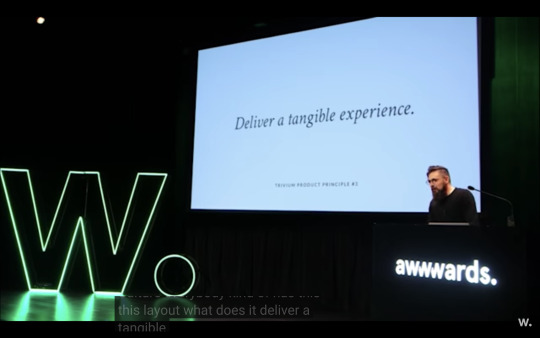
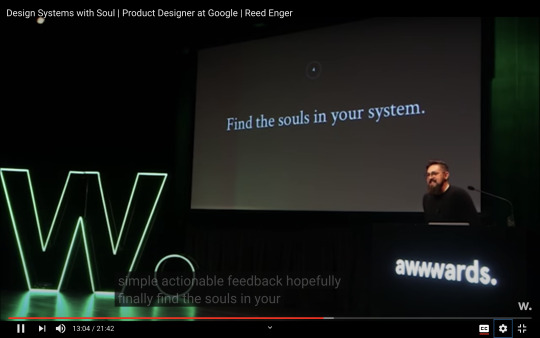
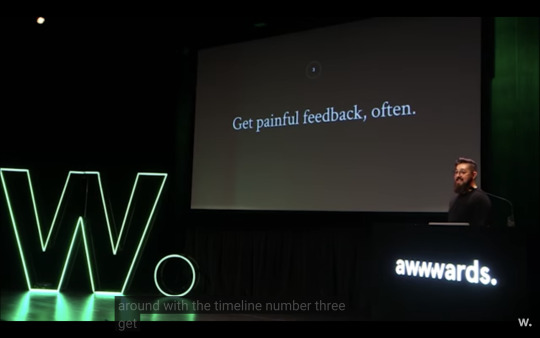


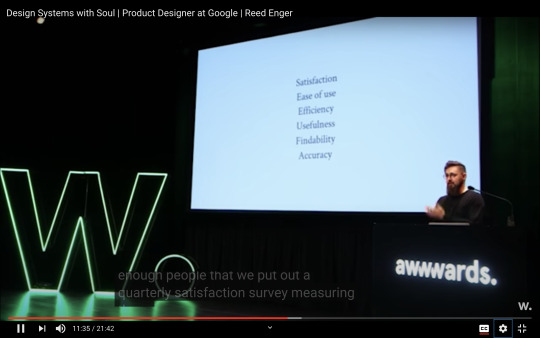

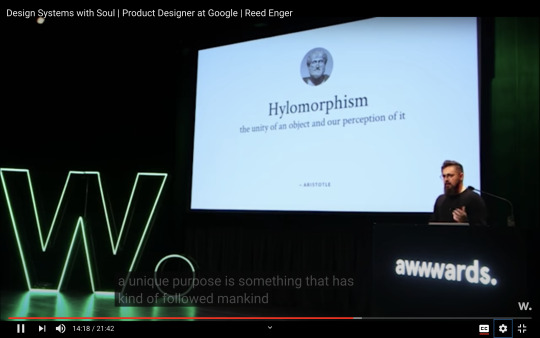


Reed Enger | Designer google | Design Systems
PART 2
Exploring the souls of design systems13 min read
Nathania Gilson
• Aug 16, 2019
Link copied to clipboard
Reed Enger is an artificial intelligence experience designer at Google. He’s also the founder of Trivium Art History, a digital platform that shares the stories behind 30,000 years of creativity.
After graduating from the University of Northwestern in 2009, Reed left behind his training as a print designer. Employers at the time were more interested in hiring web and user experience designers. “The term ‘experience design’ was kind of frowned around early on,” Reed remembers. “It seemed a little indulgent, like, “I’m an experience designer.” Well, come on, man. You make websites.”
Reed describes his post-graduation years as the best time to build a big portfolio quickly at many of the local agencies—back then, user experience was still maturing as a discipline.
Reed Enger, the man himself.
As Reed’s knowledge expanded, he realized that experience design was more than just building websites: “I have to never take it for granted that I might have to learn a brand new language, metaphorically, to tackle new problems.”
In 2017, after spending a few years embedded in New York agencies, he moved to Seattle to join the Google Cloud team. Here, he was tasked with driving a seamless experience of design systems for one of the technology giant’s most important divisions at the company.
“You should have fun when you’re designing. I would love to think of a design system as just a box of toys.”
This involved having a direct impact on how people interact with products and services like computing, data storage, data analytics, and machine learning every day.
We spoke to Reed about design as a form of patience and caretaking, contemplation as a kind of counter culture, and why it’s a good thing to remain skeptical about the future of design systems.
[Be secure in the future of your own system with InVision Design System Manager]
ID: Why is it important to keep human-centred design in mind when building design systems?
Enger: It’s that idea that you need to design for a person and, to do that, you have to understand what they need and hopefully some of how they think. That’s, I think, what you can do with a design system.
Because a lot of design systems sort of grew out of code repositories, because developers were way, way ahead of designers when it comes to modular, flexible, reusable kind of componentry. So, I think that as part of that legacy you do wind up with design systems that are pretty formal and sort of optimized for Ctrl+F. They know exactly what they’re looking for and then know how to get to it. It’s a resource and less of a guidebook.
UX can make design systems more of a guidebook—an invitation.
Design systems can get a bit of a bad rap because they’re seen as a constraint. The thing is you can’t do whatever you want, because you’ve got to work from the system. But, just like a box of Legos, a design system applied correctly is a creative tool. It’s not a limiting tool.
ID: You described yourself as a caretaker for the design specifications of the Google Cloud when you first joined. I wondered what made you use that word and how you take on the responsibility of the caretaker role in your design practice.
Enger: Caretaking is humble work. It’s not particularly flashy. It’s playing bass, not lead guitar. Working in design systems I found to be very patient work, and I don’t think that that’s a bad thing.
I’d come out of the sort of rock-and-roll New York agency scene, which was really, really fun. It was an interesting adjustment to then go to a place where a huge part of my job was just listening and identifying the challenges that future teams were working on and then supporting them however I can. My job was not to create something that had real sting, real flavor. It was to melt it away until it was strictly function and could be applied anywhere.
It’s a very invisible sort of design, working on a design system. I really came to love that. I found it to be kind of egoless. You just want the thing to work really well. You want it to be clean. You want to sweep out the cobwebs in the corners. You want to Marie Kondo that design system. It’s that same satisfaction you get from lining up your shoes in front of the door in a really nice straight line. It’s that sort of thing. Caretaking, I think, has its real benefits.
ID: How would you explain a design system to someone if the phrase didn’t
exist?
Enger: I would call it a box of Legos. I would say, “Here’s a box of toys.”
You should have fun when you’re designing. I would love to think of a design system as just a box of toys. Lots of possible combinations. And then somebody comes along every now and then, gets creative, and lights all of the toys on fire and builds a new one, which is great.
It should also be participatory. You should involve lots of people. You should share your toys. If you have a really nice toy, you should add it to the box.
ID: In your experience, how can you make a design system less intimidating
and more useful?
Enger: Edit, edit, edit. Documentation can be so long, and most of the time you don’t need the majority of it. Describe everything as simply and concisely as possible. Use visuals when you can rather than words. Provide very simple overviews that somebody can breeze through and glance their way around. Make it fast, and make it simple.
“I think that you have to get comfortable with the fact that many things can be true at once.”
It’s funny, a design system is like any other experience. You have to design it for elegance and optimize it for efficiency in the same way that you would any other experience.
ID: Can you talk a little bit more about the process of optimizing for efficiency when building a design system?
Enger: I think it’s about providing entry points that speak to different types of users. I’ll think of an example here. Someone who’s really familiar with the design system is going to want to get to what they want as fast as possible. So, you need to build in a search page. You need to have lists with the keywords that they need so that they can just get right to it. You’ve got to make sure there’s power to use your features.
Icons from Trivium’s design system
Even all the different heads on the same design system can be a big factor in how efficient something is. We had an engineering-focused portal for the design system that was basically just a huge, long list, and the engineers loved it. It was super fast. But then, for the designers, especially because the team that was growing really fast, we needed to onboard people. So, we had a visual overview that showed images relative to components.
The system should present itself in a way that is clearly understandable to the user that is using it.
ID: How do you think your knowledge of UX shaped the way that you approached living in the world on a day-to-day level?
Enger: I used to worry that being a visual person and a designer and a writer was making me dissatisfied because so much of trying to develop taste is learning to identify when something is off. It’s that carefully curated sense of dissatisfaction that lets you improve as a designer. I used to worry that it was going to turn me into a grouch.
I’ve been very relieved to discover that what it’s actually done is just develop my curiosity more, because, if you see something that feels off, that feels wrong for some reason… Maybe it’s type that’s kerned poorly. Maybe it’s a door that opens in instead of out. When you start to pay attention and notice those things, sure, you can be a grump about it, but you can also be curious about it, and you can try to figure out why that was made that way. Was it an accident, was it intentional? Maybe there’s something going on that you don’t know about.
It opened up this sense that there’s always something to learn. So I try to exist in that space of being excited to learn and keeping my eyes open to see what I can learn next.
ID: Earlier this year, you gave a talk at the Awwwards Conference in New York on how design systems have souls. Your talk alluded to the fact that everything has a soul—what do you mean by “soul?” How do you know it’s there?
Enger: When I talk about the souls that are in design, I’m using the word in an esoteric sense. There’s a variety of long, dead philosophers and scientists and nuns who referred to objects having an inherent purpose and unique and specific purpose. And everything had that purpose. A person had it, but so did a tree. So did an apple. I love that idea. And I think the thing that I like about it is that it forces you to ask the question, why is this here? What is the purpose of fill-in-the-blank? Apply it to anything at any level within a design project.
I think it’s also a really kind of lovely way of equalizing many disciplines, If everything has a unique purpose, then that purpose accounts for not only its functional behavior as a UX person would craft, but that unique purpose needs to be served by the visual design. That purpose needs to be served by the copywriter who creates the snappy call to action. That purpose is applicable to everyone who touches it, and everyone needs to be responsible to that purpose.
Then that purpose is also something that relates up and down. It’s that as above, said below hermetic thing. So, you have the small element. Is it harmonious with the larger themes of the product, the website, whatever it is that you’re working on? Everything has to make sense from the top to the bottom, the bottom to the top.
You’ve got this symphony of elements and components and design styles, and they all have to sing in tune. Their souls have to be aligned for the product to feel good.
When everything’s lined up, when all the souls are being expertly crafted and they’re all singing the same tune, then you wind up with something that feels complete and finished.
“If everything has a unique purpose, then that purpose accounts for not only its functional behavior as a UX person would craft, but that unique purpose needs to be served by the visual design.”
That kind of goes back to that idea of dissatisfaction. If you’re crafting that dissatisfaction, then you can start to see where things are out of alignment. I think that that’s what all good designers do. That’s what all good writers do. That’s what a good UX designer does. They identify where things are not serving their purpose. That’s it.
ID: In that same talk that you gave, you mentioned the word ‘glanceability’ as a key component of design systems. Why is that important?
Enger: People don’t read. People just don’t read.
ID: Why do you think that is?
Enger: I think it’s because we’re in a hurry. You know? We’re on a deadline.
A timeline of 40,000 years of art, taken from
But also, documentation and design systems tend to be pretty dry. I think that’s kind of the other component. It’s really rare to run across writing that is pleasurable to read in a design system. It’s not impossible. It’s out there, and god bless the people that put in the time and love to do that. Make it glanceable so that somebody can whip through it as quickly as possible.
I think it’s just a matter of kindness. To try and describe a dropdown menu in words is … It’s terrible to write, and it’s terrible to read. If you’ve just got a little animated image of a dropdown opening and closing, you get it right away.
It’s just easier on everyone. I mean, even better, if you’ve got a little live snippet of code, and you just have the dropdown menu there. Then somebody can go in, and they can click it, and they can see it open, click and see it close. It’s just merciful to everyone involved to try and keep things visual and short.
ID: When it comes to the history of design systems, key moments have included the publication of Christopher Alexander’s A Pattern Language, Jenifer Tidwell’s view of design systems as shortcuts in the 90s, Brad Frost’s theory of building systems, not pages, and the introduction of Google’s Material Design. Let’s look to the future, perhaps 50 years from now: what do you see as pivotal—and hope will exist—in 2069? How far could we go?
Enger: We’re in a weird spot right now with design systems. They’re primarily used by large-scale products. A lot of enterprise-level products. A lot of products that are used by millions if not billions of people.
What we’re seeing is a radical standardization in design systems. And how could you not standardize? These things have been exhaustively A/B tested, optimized down to the pixel.
So, now what we have is an extremely narrow range of highly-performant elements that are recognizable and efficiently usable by the greatest number of people possible. We have arrived—or we are close to arriving—at a point where there’s something like a design supersystem, and everybody’s kind of just using variations of basically the same thing. That’s extremely, extremely efficient.
“A good system would know when you want to use tool A versus tool B versus watch YouTube. That’s what a hyper-personalized system would allow.”
I think it’s going to flip from being a standardized design system to being an individualized and generative design system where every individual person has their own design system [assigned to them by the product], and they’re probably not even aware of it. The system’s probably being generated based on the patterns that you yourself have as you move through space, both digitally and the real world, when you interact with your devices; when you walk into a Starbucks.
The massive awareness that is being sort of slowly created, the coverage that we have now with sensors and transactions I think is going to be enough to inform a hyper-personalized design system for the individual that will then build your experiences and your tools, probably from some insane fleet of microservices.
A good system would know when you want to use tool A versus tool B versus watch YouTube. That’s what a hyper-personalized system would allow.
ID: Do you think there is such a thing as healthy skepticism about all of this?
Enger: Oh god, yeah. I think that you have to get comfortable with the fact that many things can be true at once. The same slice of code that could be hugely empowering could also be used to reinforce a surveillance state. I think skepticism is really, really important.
The potential is so incredibly, incredibly strong. It could be absolutely, radically misused. It is every day. But it could also be wonderful. You want to keep making stuff that pushes it in a wonderful direction
0 notes